药剂学英文重点整理
- 格式:doc
- 大小:684.84 KB
- 文档页数:94
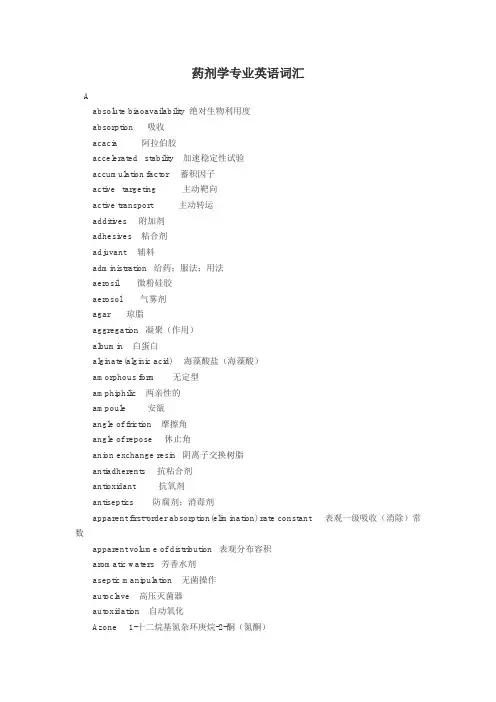
药剂学专业英语词汇Aabsolute biaoavailability 绝对生物利用度absorption 吸收acacia 阿拉伯胶accelerated stability 加速稳定性试验accumulation factor 蓄积因子active targeting 主动靶向active transport 主动转运additives 附加剂adhesives 粘合剂adjuvant 辅料administration 给药;服法;用法aerosil 微粉硅胶aerosol 气雾剂agar 琼脂aggregation 凝聚(作用)albumin 白蛋白alginate(alginic acid) 海藻酸盐(海藻酸)amorphous form 无定型amphiphilic 两亲性的ampoule 安瓿angle of friction 摩擦角angle of repose 休止角anion exchange resin 阴离子交换树脂antiadherents 抗粘合剂antioxidant 抗氧剂antiseptics 防腐剂;消毒剂apparent first-order absorption(elimination) rate constant 表观一级吸收(消除)常数apparent volume of distribution 表观分布容积aromatic waters 芳香水剂aseptic manipulation 无菌操作autoclave 高压灭菌器autoxidation 自动氧化Azone 1-十二烷基氮杂环庚烷-2-酮(氮酮)Bbactericide 杀菌剂ball mill 球磨机basewax 蜂蜡bentonite 硅皂土binder 粘合剂bioadhesive tablets 生物粘附片biocompatibility 生物相容性bioequivalence 生物等效性biologic half-life 生物半衰期Biopharmaceutics 生物药剂学biotransformation 生物转化blood-brain barrier 血脑屏障BP(British Pharmacopoeia)英国药典buccal administration 颊给药buccal tablets 口含片bulk density 堆密度Ccapacity-limited and nonlinear process 能力有限和非线形过程capillary action 毛细管作用capping 顶裂capsules 胶囊carbopol 卡波普(=carbomer,卡泊姆)carboxypolymethylene 聚羧乙烯carmauba wax 巴西棕榈蜡carrier-mediated transfer system 载体转运系统cation exchange resin 阳离子交换树脂cellulose acetate phthalate (CAP)邻苯二甲酸醋酸纤维素cetyl alcohol 十六醇,鲸蜡醇chelating agent 螯合剂chewable tablets 咀嚼片chipping 裂片chitin 壳多糖chitosan 脱乙酰壳多糖chronopharmacokinetics 时辰药物动力学clarity (test) 澄明度(检查)cloud point 浊点co-solvency 潜溶coagulation 聚沉coating 包衣cocoa butter 可可豆脂cohesiveness 粘着性colloid mill 胶体磨comminution 粉碎(作用)complex coacervation method 复凝聚法content uniformity test 含量均匀试验controlled release preparation 控释制剂coprecipitate 共沉淀物coulter counter 库氏计数器cracking 松片creaming 乳析creatinine clearance 肌肝清除率critical micelle concentration (CMC) 临界胶团浓度croscarmellose sodium , CCNa 交联羧甲基纤维素钠crospovidone 交联聚维酮cyclodextrin inclusion compound 环糊精包合物Ddecoction 箭煮法,汤剂deflocculating agent 反絮凝剂delayed release 延缓释放dextrin 糊精die 模圈differential scanning calorimetry (DSC) 差示扫描量热法differential thermal analysis (DTA) 差示热分析法diffussion coefficient 扩散系数diluents 稀释剂dimethyl acetamide ,DMA 二甲基乙酰胺dimethyl formamide,DMF 二甲基甲酰胺dimethyl sulfoxide DMSO 二甲基亚砜disinfectant 消毒剂;灭菌剂disintegrant 崩解剂dispersible tablets 分散片displacement value 置换价dissolution 溶出distribution 分布dosage form 剂型dosage regimen 给药方案dosing interval 给药间隔drug compatibility 药物配伍drug delivery system 药物传递系统,给药系统drug disposition 药物处置duration 作用持续期dustibility 松散性Eeffervescent tablets 泡腾片elimination 消除elixirs 酏剂emulsions 乳剂emulsification 乳化(作用)encapsulation coefficency 包封率endocytosis 内吞作用enemas 灌肠剂enteric coated tablets 肠衣片enterohepatic cycle 肠肝循环equivalent diameter 等价径erodible matrix 溶蚀性骨架ethylene-vinyl acetate copolymer(EVAC) 乙烯-醋酸乙烯共聚物ethyl cellulose EC 乙基纤维素eudragit 丙烯酸树脂eutectic mixture 低共熔混合物excipient 赋形剂,辅料extended release 持续释放extract preparation 浸出制剂extracts 浸膏剂extravascular administration 血管外给药Ffacilitated diffusion 促进扩散fast 禁食feed shoe 饲粉靴fillers 填充剂film coated tablets 薄膜衣片filter candle(stick) 滤棒first pass effect 首过效应flavoring agent 矫味剂flocculant 絮凝剂fluctuation 波动性fluid bed coating/granulation 流化床包衣制粒fluid energy mills 流能磨fluid extracts 流浸膏剂fluid mosaic model 液体镶嵌模式Food and Drug Administration (FDA) 药品食品管理局formulation 处方friability 脆碎度fusion 融合作用Ggargles 漱口剂gelatin 明胶gelatin glycerin 甘油明胶glidants 助流剂glomerular filtration 肾小球滤过glycerites 甘油剂glyceryl monostearate 单硬脂酸甘油酯glycoprotein 糖蛋白granule density 粒密度greazing bases 油脂性基质guest molecule 客分子Hhealthy volunteer 健康受试者high-efficiency particle air filter 高效空气过滤器horizontal laminar flow 水平层流hopper 加料斗,饲粉器host molecule 主分子hydrocarbon bases 烃类物质hydrogel matrix 水凝胶骨架hydrogenated vegetable oils 氢化植物油hydrophile-lipophile balance(HLB) 亲水亲油平衡值hydrophilic matrix 亲水性骨架hydroscopicity 吸湿性hydrotropic agent 助溶剂hydroxypropylmethyl cellulose HPMC 羟丙基甲基纤维素hydroxypropylstarch 羟丙基淀粉Iimplants 植入剂in vitro 体外in vivo 体内inclusion compound 包合物incompatibility 配伍禁忌industrial pharmacy 工业药剂学infusion 浸渍;浸剂;输注inhalation aerosols 吸入气雾剂injections 注射剂instantaneous rate 瞬时速度interfacial polymerization 界面缩聚法intra uterine device(IUD) 宫内给药器intra vaginal ring (IVR) 阴道环intravenous infusion 静脉滴注inulin 菊粉iontophoresis 离子等渗irrigations 灌洗剂iso-osmotic solution 等渗溶液isotonic solution 等张溶液isotonicity 等张性;等渗性JP(The Pharmacopoeia of Japan) 日本药局方Kkidney function 肾功能kinetics parameter 动力学参数LL-hydroxypropyl cellulose,L-HPC 低取代羟丙基纤维素lactose 乳糖lag time 时滞lake 色淀lamiar flow clean bench 层流洁净工作台lamination 层裂leak test (testing) 漏气实验lecithin(e) 卵磷脂limuis test 鲎实验liniments 搽剂liposomes 脂质体loading dose 负荷剂量lotions 洗剂lubricants 润滑剂lyophilic亲液的;亲媒的lyophilization 冷冻干燥lyophobic 疏液的;疏媒的(胶体)Mmaceration 浸渍(作用)macromolecular solution 高分子溶液macrovesicle liposome 大多孔脂质体magnetic microspheres 磁性微球maintenance dose 维持剂量matrix tablets 骨架片mean residence time(MRT) 平均滞留时间medicinal liquor 酒剂membrane evaporator 薄膜浓缩器metastable 亚稳的methyl cellulose,MC 甲基纤维素micelle 胶团Michaelis-Menten kinetics M-M动力学micro-spheres 微球microcapsules 微囊microcrystalline cellulose 微晶纤维素microemulsions 微乳microencapsulation 微型包囊术micromeritics 粉粒学micronise 微粉化microporous membrane 微孔膜microvilli 微絨毛migration 迁移minimum effective concentration (level) 最小有效浓度minimum toxic concentration 最小中毒浓度mixer 混合机mixtures 合剂moistening agent 润湿剂monoclonal antibody 单克隆抗体mottling 色斑mucilages 胶浆剂multilamellar,multiple compartment liposomes 多室脂质体multiple compartment model 多室模型multiple dosing 多剂量给药multiple emulsion 复合型乳剂Nnanocapsules 毫微胶囊nanoparticles 毫微粒nanospheres 毫微球naris drops 滴鼻剂nasal administration 鼻腔给药nonlinear pharmacokinetics 非线性药物动力学National Formulary 美国药局方Nipagin(parabens) 尼泊金Oointments 软膏剂oleaginous bases 油性基质one compartment model 单室模型onset 起效时间ophthalmic preparation 眼用制剂optimization technique 优化技术oral administration 口服给药oral osmotic pumps 口服渗透泵Pparaffin 石蜡paregal 0 平平加0partition coefficient 分配系数passive diffusion 被动扩散passive target preparation 被动靶向制剂pastes 糊剂peeling 剥落pellet 小丸penetration enhancers 穿透促进剂percoltation 渗漉percutaneous administration 经皮给药permeability coefficient 穿透系数pH-partition theory pH-分配学说pharmaceutics 药剂学pharmacokinetics 药物动力学pharmacopoeia 药典pharmacy 药学;药房phase separation-coacervation 相分离凝聚法phase transition temperature 相变温度picking 粘连pills 丸剂plasters 硬膏剂plastic flow 塑性流动plasticizer 增塑剂plateau concentration(level) 坪浓度pluronic F-68 普朗尼克F-68polishing,smoothing 打光Poloxamer 泊洛沙姆polyacrylamide 聚丙烯酰胺polyacrylic acid 聚丙烯酸polyethylene glycols,PEC 聚乳酸polymerization 聚合polymethyl methacrylate 聚甲基丙烯酸甲酯polymorphism 多晶型(现象)polyvinyl alcohol,PVA 聚乙烯醇polyvinylpyrrolidone(PVP)(povidone) 聚乙烯吡咯烷酮(聚维酮)porosity 空隙率powders 散剂preformulation 处方前工作pregelatinized starch 预胶化淀粉prescription 处方preservative 防腐的,防腐剂prodrug 前体药物propellants 抛射剂pseudo first order reaction 伪一级反应pseudoplastic flow 伪塑性流动pulsed and regulated drug delivery system 脉冲式和自调式释药系统pulverization 粉碎(作用),研磨(作用)punch 冲头pyrogens 热原Rrate method 速率法rate-limiting step 限速步骤rectal dosage form 直肠给药剂型relative bioavailability 相对生物利用度residuals method 残数法rheology 流变学Ssedimentation 沉降(作用)semipermeable membrane 半透膜shellac 虫胶sieves 筛(子),筛(分)sigma-minus method 总量减去法silicones 硅酮,硅油simple coacervation method 单凝聚法single-punch press 单冲压片机sintered glass filter 垂溶玻璃滤器sodium carboxyl methyl cellulose,CMC-Na 羧甲基纤维素钠sodium carboxyl methyl starch,CMS-Na 羧甲基淀粉钠sodium lauryl sulfate 十二烷基硫酸钠solid dispersion 固体分散体solidification 固化solubilization 增溶作用solvate 溶剂化物sonication dispersion method 超声分散法Spans 司盘类specific acid-base catalysis 特殊酸碱催化specification 规格,说明书spermacete 鯨蜡spirits 醑剂sprays 喷雾剂stability 稳定性starch 淀粉statistical moment 统计矩steady-state 稳态stearyl alcohol 十八醇,硬脂醇sterilization 灭菌,消毒sterilizer 杀菌器,消毒器sticking 粘冲sublingual tablets 舌下片sugar coated tablets 糖衣片superdisintegrants 超级崩解剂suppositories 栓剂surfactant 表面活性剂suspending agent 助悬剂suspensions 混悬剂sustained release prepatation 缓释制剂sweeting agent 甜味剂syrups 糖浆剂systemic clearance 总清除率Ttablets 片剂talc 滑石粉targeted drug delivery system(TDDS) 靶向给药体系(系统)terylene 涤纶薄膜the area under the plasma concentration-time curve 血浓时间曲线下面积The Extra Pharmacopoeia 药学大全The International Pharmacopoeia 国际药典the membrane of epithelial cell 上皮细胞膜the rate of gastric emptying 胃排空速率theobroma oil 可可豆油therapeutic concentration range 治疗浓度范围therapeutic equivalence 治疗等效性thixotropy 触变形time course 经时过程Tinctures 酊剂tragacanth 西黄耆胶transdermal therapeutic system,TTS 透皮治疗系统transport 转运trapezoidal rule 梯形法则true density 真密度tubular reabsorption 肾小管重吸收tubular secretion 肾小管分泌Tweens 吐温类Uultrafiltration 超滤unilamellar,single compartment liposomes 单室脂质体urinary excretion 尿排泄USP(The Pharmacopoeia of United States) 美国药典VVaseline(e) 凡士林vertical laminar flow 垂直层流Wwater for injection 注射用水wettability 可湿性wetting agent 润湿剂Zzein 玉米脘。
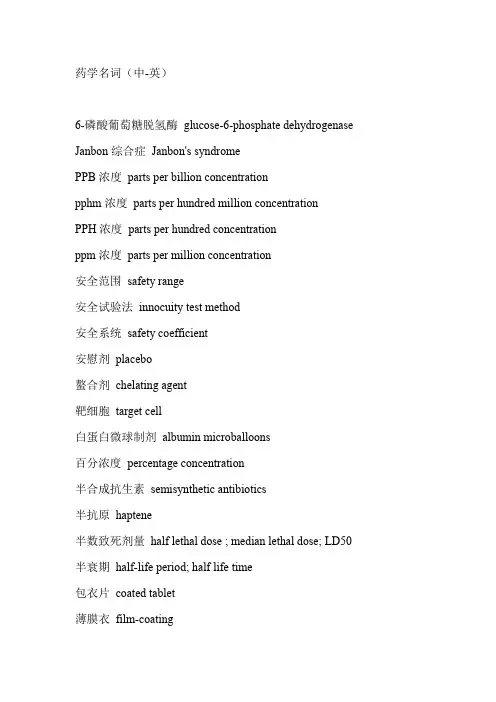
药学名词(中-英)6-磷酸葡萄糖脱氢酶glucose-6-phosphate dehydrogenase Janbon综合症Janbon's syndromePPB浓度parts per billion concentrationpphm浓度parts per hundred million concentrationPPH浓度parts per hundred concentrationppm浓度parts per million concentration安全范围safety range安全试验法innocuity test method安全系统safety coefficient安慰剂placebo螯合剂chelating agent靶细胞target cell白蛋白微球制剂albumin microballoons百分浓度percentage concentration半合成抗生素semisynthetic antibiotics半抗原haptene半数致死剂量half lethal dose;median lethal dose;LD50半衰期half-life period;half life time包衣片coated tablet薄膜衣film-coating饱和溶液saturated solution贝克勒尔Becquerel被动免疫passive immunity被动转运passive transport崩解度disintegration崩解剂disintegrants必需氨基酸essential aminoacid必需脂肪酸essential fatty acid变态反应allergy;allergic reaction表面活性surface activity表面张力surface tension丙种射线gamma rays补体complement补体系统complement system不良反应adverse reaction不完全抗原incomplete antigen搽剂liniments长期毒性实验long term toxicity test长效制剂prolonged action preparation肠肝循环enterohepatic circulation肠溶控释片enteric controlled release tablets 肠溶衣enteric coating处方prescription;recipe穿透促进剂penetration enhancers磁性控释制剂magnetic controlled release dosage form 磁性药物制剂magnetic medicinal preparations大分子macromolecule单克隆抗体monoclonal antibody胆碱酯酶cholinesterase当量equivalent weight当量定律equivalent law当量浓度normality当量溶液normal solution等张溶液isotonic solution低聚糖oligosaccharides低密度脂蛋白low density lipoprotein滴定titration滴定曲线titration curve滴丸剂pill递质transmitter电解electrolyzation电解质electrolyte酊剂tincture定向药物制剂directed pharmaceutical preparations毒理学toxicology毒性反应toxic response;toxic reaction短期致癌实验short term carcinogenic test 对因治疗etiological treatment对映体antipode对症治疗symptomatic treatment多功能酶multifunctional enzyme多剂量给药multiple dose administration 多糖polyose多肽polypeptide儿茶酚胺catecholamine二重感染superinfection发酵fermentation法定处方official formula芳族化合物aromatic compound放射毒理学radiotoxicology放射药剂学radiopharmaceutics非必需氨基酸non-essential amino acid非去极化型肌松药nondepolarizer分子病molecular disease分子溶液molecular solution分子生物学molecular biology分子药理学molecular pharmacology辅基prosthetic group辅料excipients辅酶coenzyme副作用side effect附加剂additive干燥剂desiccant;drying agent肝首过效应first pass effect of hepar感受器receptor高敏性hyperreactivity个体差异性individual differences;individual variation 给药方案或给药速度dosage regimen or dose rate给药间隔dosing interval工业药剂学industrial pharmacy共价键covalent bond光量子light quantum广谱抗生素broad-spectrum antibiotic过滤filtration过敏毒素anaphylatoxin过敏性药物反应anaphylactic drug reaction过氧化物superoxide含量均匀度content uniformity核糖核酸ribonucleic acid;RNA核苷酸nucleotide合并用药drug combination合成药物synthetic drugs合剂mixture痕量元素trace element化学分析chemical analysis化学物理学chemical physics化学消毒法chemical disinfection化学药物治疗chemotherapy环境药理学environmental pharmacology基本药物essential drugs基因gene激活剂activator激活作用activation激素hormone激素原prohormone急性毒性实验acute toxicity test己糖醇细胞毒剂cytotoxic hexitols剂量dosage;dose剂量或浓度的依存性dose or concentration dependency 剂型dosage form间接致癌indirect carcinogenesis间歇灭菌法discontinuous sterilization碱中毒alkalosis;alkali-poisoning胶体溶液型药剂medical colloidal solution 嚼用片chewable tablets酵解glycolysis拮抗作用antagonism解毒作用detoxication介质mediator;transmitter;medium精神依赖性psychic dependence剧药powerful drug绝对致死剂量absolute lethal dose;LD100抗毒素antitoxin抗菌谱antibacterial spectrum抗体antibody抗血清antiserum抗药性resistance to drugs抗原antigen克当量gram-equivalent weight克当量数gram-equivalent number克分子gram-molecule;gram-mol克分子分数molar fraction克分子量gram molecular weight克分子浓度molar comcentratin;molal comcentration克原子gram-atom控释制剂controlled release preparation口腔内给药oral administration快速耐受tachyphylaxis扩散diffusion扩散系数coefficient of diffusion累积尿排泄曲线cumulative urinary excretion curves累加效应additive effect类毒素anatoxin;toxoid类固醇停药综合征steroid withdrawal syndrome冷藏cold-storage冷冻freezing;refrigeration量子药理学quantum pharmacology临床药理学clinical pharmacology临床药学chlinical pharmacy卤化物halogenide埋植剂implants慢通道slow pathway慢性毒性实验chronic toxicity test;long term toxicity test 酶enzyme酶原proenzyme免疫抑制剂immunosuppressant;immuno inhibitor免疫原性immunogenicity免疫增强剂immunoenhancement敏感性sensitivity摩尔mole摩尔分数浓度mol fraction concentration摩尔分子体积molar volume;mole volume摩尔浓度molarity默克索引the Merck index耐受性tolerance耐药性drug tolerance内毒素endotoxin内毒素鲎试剂测定法Limulus Amebocyte Lysate assay for endotoxin 内消旋体mesomer浓度concentration皮肤、粘膜表面给药skin and mucocutaneous administration片剂硬度tablet hardness气凝胶aerogel气溶胶aerosol气体分析gas analysis气雾剂aerosol前体药物prodrug鞘内注射intrathecal injection全酶与辅基holonzyme and prosthetic group 人工合成抗原artificial antigen人工免疫artificial immunization人种药理学ethnopharmacology日内瓦命名法Geneva nomenclature溶剂solvent;dissolvent溶解dissolution;dissolving溶菌酶lysozyme溶血hemolysis溶质solute三羧酸循环tricarboxylic acid cycle杀菌活性bactericidal activity杀菌作用bactericidal effect身体依赖性physical dependence神经毒素neurotoxin肾上腺素能神经adrenergic nerve肾上腺素能受体adrenergic receptor渗透压osmotic pressure生长曲线growth curve生物胺biogenic amine生物半衰期biological half life生物化学biochemistry生物碱alkaloid生物利用度bioavailability生物统计学biometrics;biometry生物药剂学biopharmacy生物制品biological product生药crude drugs时辰药理学chronopharmacology时间感受性chronosusceptability时间治疗chronotherapy时效关系time-effect relationship时值chronaxia;chronaxy时滞lag time世界卫生组织World Health Organization;WHO 噬菌体bacteriophage收敛药astringent手性药物chiral drug首过效应first-pass effect受体receptor受体激动剂receptor stimulant受体拮抗剂receptor antagonist双盲法double-blind technique水解(作用)hydrolysis糖异生作用gluconeogenesis体表面积body surface area体积比浓度volume by volume concentration体液body fluid体液免疫humoral immunity天然抗体natural antibody天然抗原natural antigen天然免疫natural immunity天然药物crude drugs;natural drugs调剂学dispensing pharmacy同位素isotope突变mutation吞噬作用phagocytosis外毒素exotoxin外消旋体raceme完全抗原complete antigen王水aqua regia;nitrohydrochloric acid微粒体酶microsomal enzyme微量元素trace element稳态血药浓度steady state plasma concentration物理药剂学physical pharmaceutics吸入法inhalation吸收速率常数absorption rate constant 细胞免疫cellular immunity腺苷磷酸adenosine phosphate限制性剧药restrictive holagogue相对给药间隔relative dosage interval 相加作用additive effect;addition向靶给药targetable drug delivery消除速率常数elimination rate constant 效价potency效价单位potency unit效价强度potency效应effect效应器effector效应物effector协定处方cipher prescription协同作用synergism兴奋性excitability序贯设计sequential design悬浮液suspension选择性selectivity血管内给药intravascular administration血管外给药extravascular administration血浆plasma血浆代用液plasma substitute血浆蛋白结合率plasma protein binding ratio血脑屏障blood-cerebral barrier血清serum血容量扩充剂blood volume expander血药浓度blood concentration血液凝固blood coagulation血液制品blood products亚急性中毒subacute intoxication;subacute poisoning 亚硝酸盐中毒nitrite poisoning眼用膜剂ocular inserts药—时半对数曲线semi-logarithmic curve of drug-time 药—时曲线drug-time curve药峰浓度peak concentration of drug药峰时间peak time of drug药剂等效性pharmaceutical equivalence药剂学pharmaceutics药理学pharmacology药敏试验drug sensitive test药品负责期allotted date of drug quality ensuring by manufacturer 药品管理法drug administration law药品批号drug batch number药品使用期limit date of using a drug after its production药品有效期expiry date;date of expiration药品质量标准drug standard药物代谢drug metabolism药物代谢酶drug metablic enzyme药物的体内过程intracorporal process of drugs药物动力学模型pharmacokinetics model药物反应drug reaction药物分布drug distribution药物分析pharmaceutical analysis药物化学pharmaceutical chemistry药物排泄drug excretion药物吸收drug absorption药物相互作用drug interaction药物消除drug elimination药物蓄积drug accumulation药物学pharmacology;materia medica药物遗传学pharmacogenetics药效动力学pharmacodynamics药源性疾病drug-induced diseases乙酰胆碱乙酰胆碱acetylcholine乙酰胆碱酯酶acetylcholinesterase抑菌活性bacteriostatic activity抑菌作用bactriostasis异构酶isomerase营养素nutrient硬膏剂plaster有效半衰期effective halt有效率effective rate有效浓度effective concentration右旋糖dextrose右旋体dextrorotatory form阈剂量threshold dose载体carrier皂甙saponins脂质体liposome直肠给药rectal administration直线相关linear correlation纸型片剂oral medicaed soluble paper 致癌实验carcinogenic test致癌物carcinogen致畸试验teratogenic test致畸物teratogen致敏试验sensitization test致敏作用sensitization致死量fatal dose;lethal dose制剂preparation制剂学technology of pharmaceutics制药化学pharmaceutical chemistry治疗等效(值)therapeutic equivalence治疗量therapeutic dose治疗药物临测therapeutic drug monitoring;TDM治疗指数therapeutic index TI治疗作用therapeutic action中毒intoxication;poisoning中华人民共和国卫生部药品标准Drug Standard of Ministry of Public Health of the People's Republic of China中间体intermediate助滤剂filter aid助溶剂complex solubilizer助悬剂suspending agent自身免疫autoimmunity组胺histamine最大耐受剂量maximal tolerable dose;LDO最大无作用剂量maxial noneffective dose;EDO 最小显著差数least significant difference最小有效量minimal effective dose最小致死剂量minimal lethal dose;MLD左旋糖levulose左旋体levorotatory form佐剂adjuvant。
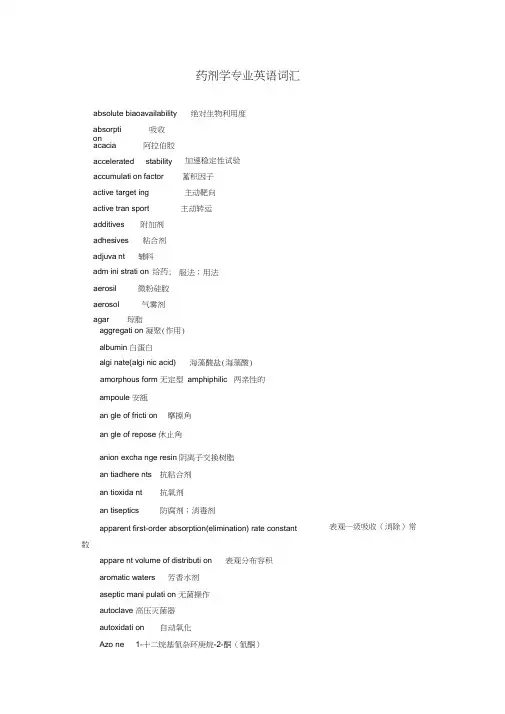
药剂学专业英语词汇absolute biaoavailability绝对生物利用度aggregati on 凝聚(作用) albumin 白蛋白 algi nate(algi nic acid)海藻酸盐(海藻酸)amorphous form 无定型 amphiphilic 两亲性的 ampoule 安瓿 an gle of fricti on摩擦角an gle of repose 休止角anion excha nge resin 阴离子交换树脂 an tiadhere nts 抗粘合剂 an tioxida nt 抗氧剂 an tiseptics防腐剂;消毒剂apparent first-order absorption(elimination) rate constant 数appare nt volume of distributi on 表观分布容积aromatic waters芳香水剂aseptic mani pulati on 无菌操作 autoclave 高压灭菌器 autoxidati on 自动氧化Azo ne1-十二烷基氮杂环庚烷-2-酮(氮酮)absorption 吸收 acacia 阿拉伯胶 acceleratedstability加速稳定性试验 accumulati on factor 蓄积因子 active target ing 主动靶向 active tran sport 主动转运additives 附加剂 adhesives 粘合剂 adjuva nt辅料adm ini strati on 给药; 服法;用法 aerosil 微粉硅胶 aerosol气雾剂agar 琼脂表观一级吸收(消除)常bactericide 杀菌剂ball mill 球磨机basewax 蜂蜡benton ite 硅皂土bin der 粘合剂bioadhesive tablets 生物粘附片biocompatibility 生物相容性bioequivale nee 生物等效性biologic half-life 生物半衰期Biopharmaceutics 生物药剂学biotra nsformati on 生物转化blood-bra in barrier 血脑屏障BP ( British Pharmacopoeia ) 英国药典buccal adm ini strati on 颊给药buccal tablets 口含片bulk den sity 堆密度Ccapacity-limited and non li near process 能力有限和非线形过程capillary action 毛细管作用capp ing 顶裂capsules 胶囊carbopol 卡波普 (=carbomer,卡泊姆)carboxypolymethyle ne 聚羧乙烯carmauba wax 巴西棕榈蜡carrier-mediated transfer system 载体转运系统cati on excha nge resin 阳离子交换树脂cellulose acetate phthalate (CAP)邻苯二甲酸醋酸纤维素cetyl alcohol 十六醇,鲸蜡醇chelati ng age nt 螯合剂chewable tablets 咀嚼片chipp ing 裂片chitin 壳多糖chitosa n 脱乙酰壳多糖chro nopharmacok in etics 时辰药物动力学clarity (test) 澄明度(检查)cloud point 浊点co-solve ncy 潜溶coagulati on 聚沉coat ing 包衣cocoa butter 可可豆脂cohesive ness 粘着性colloid mill 胶体磨com minu ti on 粉碎(作用)complex coacervatio n method 复凝聚法content uni formity test 含量均匀试验con trolled release preparati on 控释制剂coprecipitate 共沉淀物coulter coun ter 库氏计数器crack ing 松片cream ing 孚L析creat inine cleara nee 肌肝清除率critical micelle concen tratio n (CMC) 临界胶团浓度croscarmellose sodium , CCNa 交联羧甲基纤维素钠crospovido ne 交联聚维酮cyclodextri n in clusi on compo und 环糊精包合物Ddecoction 箭煮法,汤剂deflocculati ng age nt 反絮凝剂delayed release 延缓释放dextri n 糊精die 模圈differe ntial sca nning calorimetry (DSC) 差示扫描量热法differe ntial thermal an alysis (DTA) 差示热分析法diffussi on coefficie nt 扩散系数dilue nts 稀释剂dimethyl acetamide ,DMA 二甲基乙酰胺dimethyl formamide,DMF 二甲基甲酰胺dimethyl sulfoxide DMSO 二甲基亚砜disi nfecta nt 消毒剂;灭菌剂dis in tegra nt 崩解剂dispersible tablets 分散片displaceme nt value 置换价dissoluti on 溶出distributi on 分布dosage form 剂型dosage regime n 给药方案dos ing in terval 给药间隔drug compatibility 药物配伍drug delivery system 药物传递系统,给药系统drug dispositi on 药物处置duratio n 作用持续期dustibility 松散性Eeffervesce nt tablets 泡腾片elim in ati on 消除elixirs 酏剂emulsio ns 孚L齐Uemulsificatio n 孚L化(作用)en capsulati on coeffice ncy 包圭寸率en docytosis 内吞作用en emas 灌肠剂en teric coated tablets 肠衣片en terohepatic cycle 肠肝循环equivale nt diameter 等价径erodible matrix 溶蚀性骨架ethyle ne-vi nyl acetate copolymer(EVAC) 乙烯-醋酸乙烯共聚物ethyl cellulose EC 乙基纤维素eudragit 丙烯酸树脂eutectic mixture 低共熔混合物excipie nt 赋形剂,辅料exte nded release 持续释放extract preparati on 浸出制剂extracts 浸膏齐Uextravascular adm ini strati on 血管外给药Ffacilitated diffusi on 促进扩散fast 禁食feed shoe 饲粉靴fillers 填充剂film coated tablets 薄膜衣片filter can dle(stick) 滤棒first pass effect 首过效应flavori ng age nt 矫味剂floccula nt 絮凝剂fluctuatio n 波动性fluid bed coati ng/gra nu lati on 流化床包衣制粒fluid en ergy mills 流能磨fluid extracts 流浸膏剂fluid mosaic model 液体镶嵌模式Food and Drug Admi nistratio n (FDA) 药品食品管理局formulatio n 处方friability 脆碎度fusio n 融合作用Ggargles 漱口剂gelatin 明胶gelat in glyceri n 甘油明胶glida nts 助流剂glomerular filtrati on 肾小球滤过glycerites 甘油剂glyceryl mono stearate 单硬脂酸甘油酉旨glycoprote in 糖蛋白granule den sity 粒密度greaz ing bases 油脂性基质guest molecule 客分子Hhealthy volu nteer 健康受试者high-efficie ncy particle air filter 高效空气过滤器horiz on tal lam inar flow 水平层流hopper 加料斗,饲粉器host molecule 主分子hydrocarb on bases 烃类物质hydrogel matrix 水凝胶骨架hydroge nated vegetable oils 氢化植物油hydrophile-lipophile bala nce(HLB) 亲水亲油平衡值hydrophilic matrix 亲水性骨架hydroscopicity 吸湿性hydrotropic age nt 助溶剂hydroxypropylmethyl cellulose HPMC 羟丙基甲基纤维素hydroxypropylstarch 羟丙基淀粉Iimpla nts 植入齐Uin vitro 体夕卜in vivo 体内in clusi on compo und 包合物in compatibility 配伍禁忌in dustrial pharmacy 工业药剂学in fusion 浸渍;浸剂;输注in halatio n aerosols 吸入气雾剂injectio ns 注射剂in sta ntan eous rate 瞬时速度in terfacial polymerizati on 界面缩聚法intra uteri ne device(IUD) 宫内给药器intra vaginal ring (IVR) 阴道环in trave nous infusion 静脉滴注inulin 菊粉ion tophoresis 离子等渗irrigati ons 灌洗剂iso-osmotic soluti on 等渗溶液isot onic soluti on 等张溶液isoto nicity 等张性;等渗性JP(The Pharmacopoeia of Japa n) 日本药局方Kkid ney function 肾功能kin etics parameter 动力学参数LL-hydroxypropyl cellulose,L-HPC 低取代羟丙基纤维素lactose 乳糖lag time 时滞lake色淀lamiar flow clea n bench 层流洁净工作台lam in ati on 层裂leak test (test in g) 漏气实验lecithi n(e)卵磷脂limuis test 鲎实验lin ime nts 搽齐Uliposomes 脂质体loadi ng dose 负荷剂量lotions 洗剂lubrica nts 润滑剂lyophilic亲液的;亲媒的lyophilizati on 冷冻干燥lyophobic 疏液的;疏媒的(胶体)Mmacerati on 浸渍(作用)macromolecular soluti on 高分子溶液macrovesicle liposome 大多孑L脂质体magn etic microspheres 磁性微球maintenance dose 维持剂量matrix tablets 骨架片mea n reside nee time(MRT) 平均滞留时间medici nal liquor 酒剂membra ne evaporator 薄膜浓缩器metastable 亚稳的methyl cellulose,MC 甲基纤维素micelle 胶团Michaelis-Menten kinetics M-M 动力学micro-spheres 微球microcapsules 微囊microcrystalli ne cellulose 微晶纤维素microemulsio ns 微孚Lmicroe ncapsulatio n 微型包囊术micromeritics 粉粒学micronise 微粉化microporous membra ne 微孑L膜microvilli 微絨毛migrati on 迁移mi nimum effective concen trati on (level) 最小有效浓度minimum toxic concen trati on 最小中毒浓度mixer混合机mixtures 合剂moiste ning age nt 润湿剂monoclonal an tibody 单克隆抗体mottling 色斑mucilages 胶浆剂multilamellar,multiple compartme nt liposomes multiple compartme nt model 多室模多室脂质体型multiple dosi ng 多剂量给药multiple emulsi on 复合型乳剂Nnano capsules 毫微胶囊nan oparticles 毫微粒nano spheres 毫微球n aris drops 滴鼻剂n asal adm ini strati on 鼻腔给药non li near pharmacok in etics 非线性药物动力学Nati onal Formulary 美国药局方Nipagi n( parabe ns) 尼泊金Ooin tme nts 软膏齐Uoleagi nous bases 油性基质one compartme nt model 单室模型on set 起效时间ophthalmic preparati on 眼用制剂optimizati on tech nique 优化技术oral adm ini stratio n 口服给药oral osmotic pumps 口服渗透泵Pparaffin 石蜡paregal 0 平平加0partiti on coefficie nt 分配系数passive diffusi on 被动扩散passive target preparatio n 被动靶向制剂pastes糊剂peeli ng 剥落pellet小丸pen etrati on enhancers 穿透促进剂percoltati on 渗漉percuta neous adm ini strati on 经皮给药permeability coefficie nt 穿透系数pH-partiti on theory pH- 分配学说pharmaceutics 药剂学pharmacokin etics 药物动力学pharmacopoeia 药典pharmacy 药学;药房phase separation-coacervatio n 相分离凝聚法phase tran siti on temperature 相变温度picking 粘连pills丸剂plasters 硬膏齐U plastic flow 塑性流动plasticizer 增塑剂plateau concentration (level) 坪浓度pluro nic F-68 普朗尼克F-68 polish in g,smoothi ng 打光Poloxamer泊洛沙姆polyacrylamide 聚丙烯酰胺polyacrylic acid 聚丙烯酸polyethyle ne glycols,PEC 聚乳酸polymerizati on 聚合polymethyl methacrylate 聚甲基丙烯酸甲酯polymorphism 多晶型(现象) polyv inyl alcohol,PVA 聚乙烯醇polyvi nylpyrrolido ne(PVP)(povido ne) 聚乙烯吡咯烷酮(聚维酮) porosity空隙率powders 散剂preformulatio n 处方前工作pregelat ini zed starch 预胶化淀粉prescripti on 处方preservative 防腐的,防腐剂prodrug 前体药物propella nts 抛射剂pseudo first order reaction 伪一级反应pseudoplastic flow 伪塑性流动pulsed and regulated drug delivery system脉冲式和自调式释药系统pulverization 粉碎(作用),研磨(作用) punch 冲头pyroge ns 热原Rrate method 速率法rate-limit ing step 限速步骤rectal dosage form 直肠给药剂型relative bioavailability 相对生物利用度residuals method 残数法 rheology 流变学Ssedime ntati on 沉降(作用) semipermeable membra ne 半透膜 shellac 虫胶sieves 筛(子),筛(分)sigma-minus method 总量减去法silicones 硅酮,硅油 simple coacervati on method 单凝聚法 sin gle-p unch press 单冲压片机sin tered glass filter 垂溶玻璃滤器sodium carboxyl methyl cellulose,CMC-Na sodium carboxyl methyl starch,CMS-Na sodium lauryl sulfate 十二烷基硫酸钠solid dispersio n 固体分散体solidificati on 固化 solubilization 增溶作用 solvate 溶剂化物 son icati on dispers ion method超声分散法Spans 司盘类specific acid-base catalysis 特殊酸碱催化 specificatio n 规格,说明书 spermacete 鯨蜡spirits 醑剂 sprays 喷雾剂 stability 稳定性 starch 淀粉 statistical mome nt 统计矩羧甲基纤维素钠 羧甲基淀粉钠steady-state 稳态stearyl alcohol 十八醇,硬脂醇sterilizatio n 灭菌,消毒 sterilizer 杀菌器,消毒器 stick ing 粘冲 subli ngual tablets 舌下片 sugar coated tablets 糖衣片 superdis in tegra nts 超级崩解剂 suppositories 栓剂 surfactant 表面活性剂 suspe nding age nt 助悬剂suspe nsions 混悬剂 susta ined release prepatati on 缓释制剂 sweet ing age nt 甜味剂syrups 糖浆剂 systemic cleara nee总清除率Ttablets 片剂talc 滑石粉targeted drug delivery system(TDDS) 靶向给药体系terylene 涤纶薄膜the area un der the plasma concen trati on-time curveThe Extra Pharmacopoeia 药学大全 The Intern atio nal Pharmacopoeia 国际药典 the membra ne of epithelial cell上皮纟田胞膜 the rate of gastric empty ing胃排空速率 theobroma oil 可可豆油therapeutic concen trati on range治疗浓度范围 therapeutic equivale nee 治疗等效性thixotropy 触变形 time course 经时过程Ti nctures 酊剂tragaca nth 西黄耆胶tran sdermal therapeutic system,TTS透皮治疗系统tran sport 转运trapezoidal rule 梯形法则true den sity 真密度(系统) 血浓时间曲线下面积tubular reabsorptio n 肾小管重吸收tubular secreti on 肾小管分泌Twee ns 吐温类Uultrafiltrati on 超滤un ilamellar,s in gle compartme nt liposomes urinary excreti on 尿排泄USP(The Pharmacopoeia of Uni ted States) V Vaseli ne(e)凡士林vertical lam inar flow 垂直层流Wwater for injecti on 注射用水wettability 可湿性wett ing age nt 润湿剂Zzein玉米脘单室脂质体美国药典。
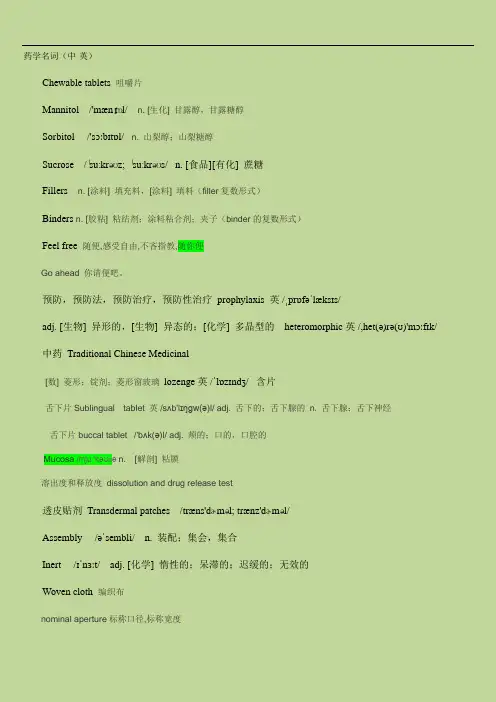
药学名词(中-英)Chewable tablets 咀嚼片Mannitol /'mænɪtɒl/ n. [生化] 甘露醇,甘露糖醇Sorbitol /'sɔːbɪtɒl/ n. 山梨醇;山梨糖醇Sucrose /ˈsuːkrəʊz; ˈsuːkrəʊs/ n. [食品][有化] 蔗糖Fillers n. [涂料] 填充料,[涂料] 填料(filler复数形式)Binders n. [胶粘] 粘结剂;涂料粘合剂;夹子(binder的复数形式)Feel free 随便,感受自由,不吝指教,随你便Go ahead 你请便吧。
预防,预防法,预防治疗,预防性治疗prophylaxis 英/ˌprɒfəˈlæksɪs/adj. [生物] 异形的,[生物] 异态的;[化学] 多晶型的heteromorphic英 /,het(ə)rə(ʊ)'mɔːfɪk/ 中药Traditional Chinese Medicinal[数] 菱形;锭剂;菱形窗玻璃lozenge 英/ˈlɒzɪndʒ/ 含片舌下片Sublingual tablet 英 /sʌb'lɪŋgw(ə)l/ adj. 舌下的;舌下腺的n. 舌下腺;舌下神经舌下片buccal tablet /'bʌk(ə)l/ adj. 颊的;口的,口腔的Mucosa /mjuː'kəʊsən. [解剖] 粘膜溶出度和释放度dissolution and drug release test透皮贴剂Transdermal patches /træns'dɚməl; trænz'dɚməl/Assembly /əˈsembli/ n. 装配;集会,集合Inert /ɪˈnɜːt/adj. [化学] 惰性的;呆滞的;迟缓的;无效的Woven cloth 编织布nominal aperture标称口径,标称宽度Flanged rim 法兰边缘Hemispherical bottom 半球形底Retard evaporation /'rɪtɑːd/ vt. 延迟;阻止;妨碍;使减速口腔片Dental patches黏膜Mucous membrane /ˈmjuːkəs/分散片Dispersible tablet /dɪ'spɝsəbl/Soluble tablets 可溶片Gargling /ˈɡɑːɡl/v. 漱;漱口;(漱口时从喉底)发出(咕噜声);漱喉;用漱口液n. 漱口;含漱剂,漱口剂;咕噜声;含酒精的饮料Opalescent /ˌəʊpəˈlesnt/ adj. 乳白色的;发乳白光的泡腾片Effervescent tablet 英/ˌefəˈvesnt/ adj. 冒泡的,沸腾的;兴奋的Sodium bicarbonate /ˈsəʊdiəm/ /ˌbaɪˈkɑːbənət/[无化] 碳酸氢钠;小苏打Carbon dioxide /ˈkɑːbən/ /daɪˈɒksaɪd/Citric acid 柠檬酸/ˈsɪtrɪk/Tartaric acid /tɑː'tærɪk/酒石酸Fumaric acid /fjʊ'mærɪk/ [有化] 富马酸;反丁烯二酸Vaginal tablet /vəˈdʒaɪnl/ 阴道片Vagina /vəˈdʒaɪnə/ n. [解剖] 阴道;叶鞘;鞘0922 disintegration test for suppositories and vaginal teblets 融变时限检查法/sə'pɑzə,tori/n. 栓剂;肛门塞药;塞药(suppository的复数形式)In a gradual, non-constant rate way 以一种渐进的,非恒定速率的方式In a specified release medium 在规定的释放介质中Gastro-resistant coating 肠溶衣(抗胃炎肠溶的)In the intestinal fluid 在肠液中Colon-specific film 结肠定位膜/ˈkəʊlən; ˈkəʊlɒn/Orally disintegrating tablets 口崩片Friability /fraiə'biliti/ n. 易碎性;脆弱Excipient 英 /ek'sɪpɪənt/ 美 /ɪk'sɪpɪənt/ 赋形剂辅料辅药赋形剂Thermolabile 英/,θɜːmə(ʊ)'leɪbaɪl; -bɪl/ adj. 受热即分解的;[生化][免疫] 不耐热的;感热的;热不稳定的Photosensitive 英/ˌfəʊtəʊˈsensətɪv/ adj. [电子] 光敏的;感光性的Mold contamination or deterioration 英 /dɪˌtɪəriəˈreɪʃn/ 发霉或变质Pharmaceutical excipientsEmulsion 英 /ɪˈmʌlʃn/ n. [药] 乳剂;[物化] 乳状液;感光乳剂Pellicle 英 /'pelɪk(ə)l/ 膜剂Propellant 英 /prəˈpelənt/ 抛射剂Solubilizer /'sɔljubilaizə/ 增溶剂Cosolvent /kəu'sɔlvənt/ n. 助溶剂Emulsifier 英 /ɪˈmʌlsɪfaɪə(r)/ n. 乳化剂,黏合剂Colourant 美/ˈkʌlərənt/ n. 颜料,染料;着色剂Adhesive 英 /ədˈhiːsɪv; ədˈhiːzɪv/ n. 粘合剂;胶带Anticaking agent [助剂] 防结块剂;抗凝剂Emollient 英 /ɪˈmɒliənt/ 润滑剂Osmotic pressure regulators 英 /ɒzˈmɒtɪk/ 渗透压调节剂Adhesive 英 /ədˈhiːsɪv; ədˈhiːzɪv/ n. 粘合剂;胶带adj. 黏合的;黏性的;可粘的Binder n. [胶粘] 粘合剂;活页夹;装订工;捆缚者;用以绑缚之物Anticaking agent [助剂] 防结块剂;抗凝剂Glidant n. 助滑剂,助流剂Preservatives 美 /prɪ'zɝvətɪv/ n. 防腐的(preservative的复数);[助剂] 防腐剂;保存剂Sweeteners n. 甜味剂(sweetener的复数形式)Suspending agent [助剂] 悬浮剂Flavoring additive coatingAromatic agent 芳香剂Antiadhesive 抗黏着剂抗粘着剂Antioxidant synergist 抗氧化增效剂英 /'sɪnədʒɪst/ n. [助剂] 增效剂,配合剂;协作剂Chelating agent /'ki:leitiŋ/化学] 螯合剂;络合剂Humectant 英/hjuːˈmektənt/ adj. 湿润的;湿润剂的n. [助剂] 湿润剂Flocculant /'flɑkjələnt/n. 凝聚剂;(治理污水用)絮凝剂Pressure sensitive adhesive [胶粘] 压敏粘着剂;[胶粘] 压感胶粘剂;压敏型黏合剂Lyophilized filler 冻干机英 /laɪ'ɒfɪlaɪz/Lyoprotectant 冻干保护剂Vacant capsule 空心胶囊Colloid stabilizer 胶体稳定剂英 /'kɒlɒɪd/ adj. 胶质的,胶体的n. 胶状体emollient vaccine adjuvant 润肤剂疫苗佐剂Mucosal 英 /,mju:'kəʊ'səl/ adj. 粘膜的Percutaneous or topical administration 经皮或局部给药英/ˌpɜːkjuːˈteɪniəs/ adj. 经皮的;经由皮肤的英/ˈtɒpɪkl/ adj. 局部的;论题的;时事问题的;局部地区的Inhalation administration 英/ˌɪnhəˈleɪʃn/ 吸入给药Ocular administration 英/ˈɒkjələ(r)/ 眼部给药。
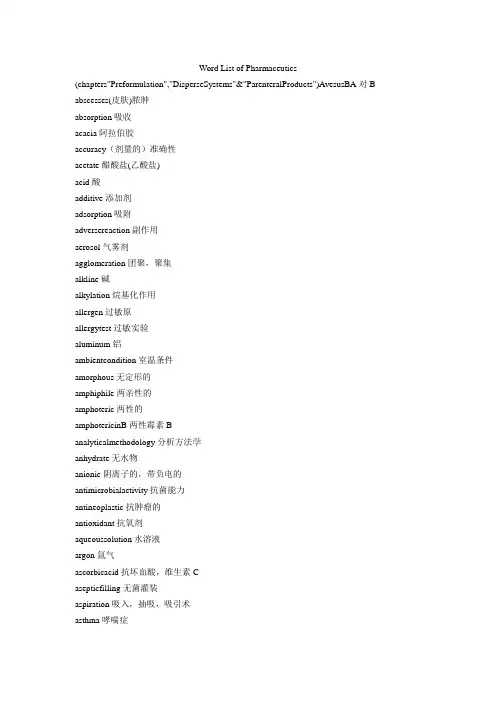
Word List of Pharmaceutics (chapters"Preformulation","DisperseSystems"&"ParenteralProducts")AvesusBA对B abscesses(皮肤)脓肿absorption吸收acacia阿拉伯胶accuracy(剂量的)准确性acetate醋酸盐(乙酸盐)acid酸additive添加剂adsorption吸附adversereaction副作用aerosol气雾剂agglomeration团聚,聚集alkline碱alkylation烷基化作用allergen过敏原allergytest过敏实验aluminum铝ambientcondition室温条件amorphous无定形的amphiphile两亲性的amphoteric两性的amphotericinB两性霉素Banalyticalmethodology分析方法学anhydrate无水物anionic阴离子的,带负电的antimicrobialactivity抗菌能力antineoplastic抗肿瘤的antioxidant抗氧剂aqueoussolution水溶液argon氩气ascorbicacid抗坏血酸,维生素Casepticfilling无菌灌装aspiration吸入,抽吸,吸引术asthma哮喘症atomizer喷雾器attractiveforces(分子间的)引力autoclaving热压灭菌(锅)Bacteriostatic抑制细菌生长的barbiturates巴比妥酸盐base碱batch-to-batchvariation(产品的)批间差异WordListofPharmaceutics第1页,共13页XH.Wei,2006.9.benzoicacid苯甲酸,安息香酸benzylalcohol苯酚binary两相的bioavailability生物利用度bioburden(灭菌时样品所带的)细菌量biopharmaceutics生物药剂学BrownianMotion布朗运动buffer缓冲液buffercapacity缓冲能力bulkingagent(冻干制剂中的)疏松剂butylrubber丁基橡胶(空气隔绝能力更好)by-product副产品Cakeshrinkage(冻干制剂的)糕体塌陷caking结块capsule胶囊carbontetrachloried四氯化碳carboxylicacid羧酸carnaubawax巴西棕榈蜡catalyze催化catheter导管,插管cationic阳离子的,带正电的cellulosederivatives纤维素衍生物celluloseesterderivative纤维素酯衍生物centrifugation离心(法)cephalosporin头孢菌素cerebrospinal脑脊髓的charcoalbed(过滤用的)活性碳层chelatingagent螯合剂chemicalmodification化学修饰chloroform氯仿cholesterol胆固醇chronictoxicity慢性毒性citrate柠檬酸盐citricacid柠檬酸clarity(注射液的)澄明度coagulation凝结,颗粒聚焦coarse(suspension)(混悬剂)颗粒增大,粗糙collapsetemperature(冻干时糕体的)塌陷温度colligative(物理性质)依数性的collision(分子或颗粒)碰撞colloidmill胶体磨colloidal胶状的,胶体的comatose昏迷的compatibility(处方中各种组分的)相容性composition成分conductiometry电导测定仪conduction(热)传导conformation(蛋白等的)构象consistency(分散体系的)浓度均一性containerheadspace容器顶部空间contamination污染contraceptiveprotection避孕用contrastagent造影剂controlled-release控释的convection(热)对流copper铜cornoil玉米油cornea角膜corrosive腐蚀性的cosmeticproduct化妆品cosolvent助溶剂cottonoil棉籽油crack(乳剂)破裂,分层creaming(乳剂)油相聚焦成膏状crenation圆锯齿状criticalmicelleconcentration(CMC)(两亲性分子的)临界胶束浓度cryoprotectant(冻干)冷冻保护剂crystalform晶型crystalhabbit晶癖crystalline晶体cubic立方的cullout精选culturetubeinoculation(无菌实验时的)培养基试管接种法cyclictemperaturestabilitytest(分散体系的)温度循环稳定性实验cysteinehydrochloride半胱氨酸盐酸盐Deamidation脱酰胺作用declay粘土decomposition分解degradation降解deionizedwater去离子水deltoid(upperarm)(上臂的)三角肌density密度deoxygenation去氧化作用depot(药物)储库depthfilterdesorption解吸附dextrose葡萄糖diabeticpatient糖尿病病人diagram相图WordListofPharmaceutics第3页,共13页XH.Wei,2006.9.diatomaceousearth硅藻土dicalciumphosphate磷酸氢钙dielectricconstant介电常数differentialscanningcalorimetry(DSC)差示热扫描diffusedoublelayer扩散双电层digotoxin地高辛DilatantFluid涨流型流体dilution稀释discoloration变色dispersedphase分散相,dispersedsystem分散体系dispersingphase连续相,分散介质dissolution溶出dissolutionrate(固体制剂的)溶出速度distillation蒸馏(法) disulfideexchange(蛋白的)二硫键交换dosageform剂型dosageregimen给药方案doubledecomposition复分解doxorubicin阿霉素drugshock局部药物浓度过高drugtransportation药物转运duralmembrane硬脊膜Electrolyte电解(质)eliminate消除emboli血栓emulsifyingagent乳化剂emulsion乳剂enantiotropicsystem互变体系endothermic吸热性endotoxin内毒素enthalpy焓entrappedvolume包封率(体积)epiduralanesthesia硬膜外麻醉equilibriumdialysis平衡透析ethylalcohol乙醇ethyleneoxide(ETO)环氧乙烷eutectic共熔的,共结晶eutectictemperature(冻干时的)低共熔温度excipient辅料,辅形剂expirationdating(药品的)过期时间explosive爆炸性的extemporaneous(制剂)即配即用的extradural硬膜外的extrapolation曲线外推.Filldose(注射剂的)灌装体积filtercartridge滤筒finepowder细粉first-orderelimination(药物的)一级清除first-passeffect(药物代谢的)首过效应fixedoil非挥发油flammable易燃的flavor矫味剂flexiblepackaging(大输液的)轻便小包装floater(注射剂内的)漂浮物flocculation(分散体系的)絮凝fluorocarbon氟碳气体foreignparticle(注射剂的)外源性颗粒物formulation(制剂的)处方formulationadditives处方中的添加剂fractal不规则的fragmentation分离,破裂freeze-drying冻干法freeze-thaw(脂质体制备的)冻融法Gastrointestinaltract(GIT)胃肠道gelfiltration凝胶过滤(法)gelatin明胶generic(药品)仿制的glasstransitiontemperature(冻干时的)玻璃态转化温度globulecoalescence球状颗粒融合gluteal(buttock)臀肌的(屁股)glyceride甘油(三)酯glycol乙二醇gravity重力grid网格Haze(注射剂中的)云雾状物heavymetal重金属hemolysis溶血heparin肝素hermetical密封的heterogeneous不同种类的,不均匀的hexagonal六角形的,六边形的histoplasminskintest组织胞浆菌素皮肤实验hoard储藏homogeneous同类的,均匀的homogenization匀质,匀化homologous类似的humanserumalbumin(HAS)人血清白蛋白humectant保湿剂humidity湿度hyaluronidase透明质酸酶hydrate水合物hydroalcoholicsolution水醇溶液hydrolysis水解hydrophilic亲水的hydrophilic-lipophilicbalance(HLB)(两亲性分子的)亲水亲油平衡值hydrophobic疏水的hydroxide氢氧化物hygiene卫生,卫生学hygroscopicity吸湿性hypertonic高渗的(高于血浆渗透压)hypodermoclysis皮下输液hypotonic低渗的(低于血浆渗透压)implant植入剂Insitu在原处,局部invitro体外(研究)invivo体内(研究)indwellingneedle(输液时的)留置针inertgas惰性气体inflammation发炎,炎症inflectionpoint曲线infrared红外(线)的ingredient(制剂的)成分inhalationtherapy吸入疗法initialdose初始剂量injection注射剂intercept截距interfacialstabilization界面稳定作用internal/externaluse内/外用intra-arterial动脉注射intracisternal脑池内的intradermal皮内注射intraepidural硬膜外注射intramuscularinjection肌肉注射intraspinal脊柱内注射intrathecal鞘内的intravenousinjection静脉注射intrinsic内在的,固有的ionization离子化ionophore离子载体iron铁irritatingdrug刺激性药物isotherm等温的isotonic等渗的(等于血浆渗透压)IVdrip静脉滴注IVinfusion静脉输注KarlFishertitrationKarlFisher滴定法(测含水量) Labeleddose标示剂量labeledpotency标示效价lab-scale实验室规模的lamellarstructure(脂质体的)片层状结构lamellarity片层laminarflowunit(空气净化时的)层流层largeproximalvein近端大静脉large-volumeparenteralfluid大输液lattice晶格latticesubstitution点阵置换leakertest(注射剂的)检漏实验lecithin卵磷脂limulusamebocytelysate(LAL)变形细胞溶菌液liposome脂质体liquefaction液化lossondrying干燥失重法(测定含水量) lottolotvariation不同生产批号间的差异lyophilic亲溶剂的lyophilize冻干(法)lyophobic疏溶剂的lyoprotectant冻干保护剂lysosome溶菌体Magnesium镁manufacture-scale生产规模的massage按摩meanparticlesize平均粒径meltingpoint熔点membranefilter膜过滤器metastable亚稳定的methyleneblue(检漏时用的)亚甲蓝指示剂methylparaben羟苯甲酯,尼泊金甲酯micelle胶束microelectrophoresis毛细管电泳microemulsion微乳micronizationtechnique微粉化技术microwaveirradiation微波辐射moist潮湿的molar摩尔的molecularbombardment分子剧烈碰撞monotone单调(曲线)monotropicsystem单向转变系统morphology形态学mucosal粘膜的multipleemulsion复乳NationalFormulary(美国的)国家处方集NDA新药申请necrosis(肌肉等)坏死neuraldamage神经损伤neutralization中和NewtonianFluid牛顿型流体nitrogenmustard氮芥nonionic非离子的nuclearmagneticresonance核磁共振nylon尼龙Odor气味operatingprocedure操作规程opticalactivity旋光性oral口服的organicsolvent有机溶剂originalheight(混悬剂的)初始体积osmoticpressure渗透压outpatient门诊病人oversaturatedsolution过饱和溶液Parenteral肠道外的,注射的(给药方式)partitioncoefficient分配系数passive/activetarget被动/主动靶向pathogenic致病的PCS(photoncorrelationspectroscopy)光子相关光度法(一种粒径测定方法)peanutoil花生油penicillinGprocaine普鲁卡因青霉素Gperse本身,本质上permeability渗透性personneltraining人员培训pesticide杀虫剂pharmacodynamics药效学pharmacokinetics药物代谢动力学pharmacopoeia药典phaseinversion(乳剂等的)转相phasevolumeratio相体积比phenol苯酚phosphatidylcholine磷脂酰胆碱phospholipid磷脂phosphorate磷酸盐physiologicalproperties生理性质pilot-scale试制规模的PlasticFliud塑性流体plunger活塞polar极性的pollen花粉polymorphism多晶型porcelain瓷器,陶土porosimeter孔隙率计posttreat后处理potassiumsalt钾盐potentiometry电势测定法pourability(液体制剂倾到时的)流动性precipitate沉淀物precipitation沉淀prefiltration预滤preformulation处方前研究prerequisite先决条件preservatives防腐剂primarydrying(冻干的)主干燥primaryenergyminimum(DLVO理论的)一级能量最低点prodrug前药productlaunch产品投放市场prolonged-action延长作用时间propagate繁殖propylene丙烯propyleneglycol丙二醇protamine鱼精蛋白protectant(冻干等的)保护剂pseudoempirical半经验的PseudoplasticFluid假塑性流体purge净化,冲洗purity纯度pyrogen热原QELS(quasi-elasticlightscattering)准静态激光散射法(一种粒径测定方法)qualityassurance质量保证qualitycontrol质量控制quantitative定量的quaternaryammonium季铵盐Racemization外消旋作用radiopaquecontrastmedia(辐射诊断的)造影剂radius半径rapidonset(药物)起效迅速rapidstirring剧烈搅拌rate-limitingstep决速步骤rawmaterial原材料reconstitution(冻干制剂的)水合redispersibility(分散体系的)再分散性redox氧化还原作用refine纯化rehydration(冻干制剂的)水合relativehumidity相对湿度reproducible可重现的repulsiveforces(分子间的)斥力reticuloendothelialsystem网状内皮系统reverseosmosis反渗透法(净化水)rheologicalproperties(液体制剂的)流变学性质ribosome核糖体rotavapor旋转蒸发仪routeofadministration给药途径rubberstopper橡胶封口塞rugosity皱褶Sample样品,取样samplinginterval取样间隔saturationsolubility饱和溶解度scale-up(生产规模)放大scanningelectronmicroscope扫描电镜screen药物筛选secondarydrying(冻干的)二级干燥secondaryenergyminimum(DLVO理论的)二级能量最低点sedimentation(混悬剂的)沉降sedimentationvolume(混悬剂的)沉降体积sesameoil芝麻油shelflife(药品的)货架期,有效期sieve筛子sinkcondition漏槽条件siphonoff虹吸,吮吸sizedistribution粒径分布sizedistribution(polydispersityindex)粒径分布(多分散性指数)sodiumchlorideinjection(0.9%saline)氯化钠注射液(0.9%生理盐水) sodiumlaurate十二烷基硫酸钠sodiummetabisulfate亚硫酸氢钠solubility溶解度solubilizedsystem增溶系统solutedistribution溶质的分布solution溶液solvateformation形成溶剂化物solventevaporationtechnique(脂质体制备的)溶剂蒸发法sorbital山梨醇spectrophotometry分光光度法spherical球形的spherule小球spherulite球粒spinalanesthesia脊髓麻醉spinalcord脊髓spore孢子spray-drying喷雾干燥stabilizer稳定剂stearicacid硬脂酸stericfactor位阻因素,空间因素stericallyhinder(因位阻作用而产生的)隐形sterilizatitial灭菌sterol甾酮stratumcorneum角质层striatedmusclefibers横纹肌纤维subcutaneousinjection皮下注射sublimation升华sulfatesalt硫酸盐sulfite亚硫酸盐sulfurdioxide二氧化硫supernatantsolution上清液supersaturatedsolution过饱和溶液supracolloid超胶体surfacetension表面张力surfactant表面活性剂surmountthepotentialenergybarrier越过能垒suspension混悬剂sustained-release缓释的sweetener甜味剂symbol符号syringe注射器systemiceffect(药物的)全身作用Tablet片剂targetdrugdeliverysystem靶向给药系统tartaricacid酒石酸terminology术语学ternary四元的therapeuticindex治疗指数thermalradiation热辐射thermodynamic热力学(的)thickeningagent增稠剂thigh大腿thimerosal硫柳汞(消毒防腐药)thin-layerchromatography薄层色譜thiocompound含硫化合物thixotropy(胶体的)触变性thrombophlebitis血栓性静脉炎thrombosis血栓tissuedehydration组织脱水tissuedistribution药物的组织分布tissuredistention(药物的)组织保留titration滴定toxicity毒性tragacanth黄芪胶treatise论文,综述trehalose海藻糖trialproductionrun试生产trough槽tuberculin(TB)结核菌素Ultimatesettledheight(混悬剂的)终沉降体积ultrasound超声ultraviolet紫外的uniformity均一性unstable不稳定的Vaccineadjuvant疫苗佐剂vacuum真空vacuumdesiccator真空干燥器validate认证vapourpressure蒸气压vasoconstrictor血管收缩剂vehicle载体vein血管,静脉veinpuncture静脉穿刺?venoclysis静脉输注vesicle小泡,囊泡vial小试管vigorousshaking剧烈晃动viscometer粘度计viscosity粘度visualacuity视觉灵敏度volatile挥发性的Waterforinjection(WFI)注射用水wavelength波长wax蜡wetting润湿whitelotion硫酸锌-硫化钾溶液withstand承受,耐受X-raydiffractionX射线衍射法(测晶体结构) Yieldvalue(流体的)塑变值Zetapotential颗粒的表面电位zinc锌。
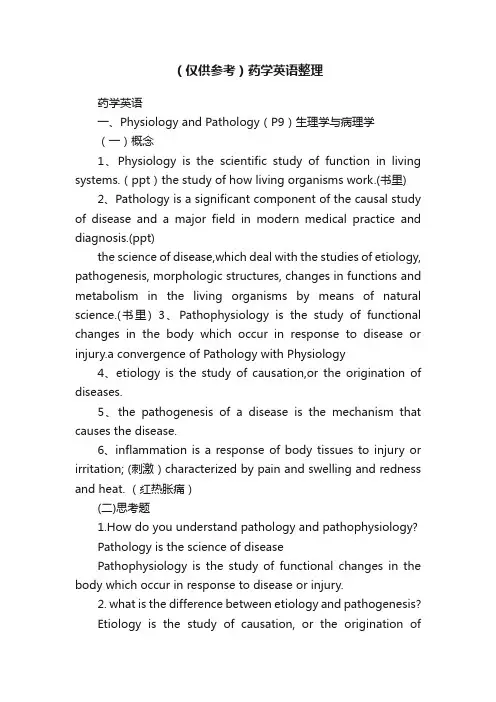
(仅供参考)药学英语整理药学英语一、Physiology and Pathology(P9)生理学与病理学(一)概念1、Physiology is the scientific study of function in living systems.(ppt)the study of how living organisms work.(书里)2、Pathology is a significant component of the causal study of disease and a major field in modern medical practice and diagnosis.(ppt)the science of disease,which deal with the studies of etiology, pathogenesis, morphologic structures, changes in functions and metabolism in the living organisms by means of natural science.(书里) 3、Pathophysiology is the study of functional changes in the body which occur in response to disease or injury.a convergence of Pathology with Physiology4、etiology is the study of causation,or the origination of diseases.5、the pathogenesis of a disease is the mechanism that causes the disease.6、inflammation is a response of body tissues to injury or irritation; (刺激)characterized by pain and swelling and redness and heat. (红热胀痛)(二)思考题1.How do you understand pathology and pathophysiology?Pathology is the science of diseasePathophysiology is the study of functional changes in the body which occur in response to disease or injury.2. what is the difference between etiology and pathogenesis?Etiology is the study of causation, or the origination ofdiseases.the pathogenesis of a disease is the mechanism that causes the disease 3. Could you explain the symptoms and signs of a disease?symptoms of a disease(“症”): as certain biologic proce sses are encroached on(侵害) ,the patient begins to feel subjectively that something is wrong., These subjective feelings are called symptoms of disease.Symptoms are subjective and can be reported only by the patient to an observer.signs of a disease(“征”):when manifestations of the disease can be objectively identified by an observer, these are terms signs of the disease.4、what is the pathogenesis of tuberculosis?the pathogenesis of tuberculosis would include the mechanisms whereby the invasion of the body by tubercle bacillus ultimately leads to the observed abnormalities Biochemistry is the study of chemical processes in living organisms.二、Medicinal Chemistry药物化学(一)概念1、Medicinal chemistry(药物化学)is the science that deal with the discovery or design of new therapeutic chemicals and the development of these chemicals into useful medicine.2、Medicine(药品drug, pharmaceutics) is a compound that interacts with a biological system, and produces a biological response (ideally desired and positive)3、Therapeutic index(治疗指数)sure of the ratio of undesirable to desirable drug effects. Therapeutic index=LD50/ED50The larger the Therapeutic index, the greater the margin of safety of drug!4、LD50(半数致死量):the lethal dose for 50% of the test animals5、ED50(半数有效量):the effective dose that produces the maximum therapeutic effect in 50% of the test animals.6、Log P(脂水分配系数)is the base-ten logarithm of the partition coefficients (分配系数)7、Chirality(手征性): a molecule is considered chiral if there exists another molecule that is of identical composition ,but which is arranged in a non-superposable mirror image.8、Bioisosteres(生物电子等排体): are substituents or groups that havechemical or physical similarities ,and which produce broadly similar biological properties.9、Bioisosterism(生物电子等排性) is a lead modification approach that has been shown to be useful to attenuate toxicity (降低毒性),modify the activity of a lead (修饰活性)and may have a significant role in the alteration of metabolism of the lead.10、Prodrug(前药)is drug which is given (taken) in an inactive form. Once administered ,the prodrug is metabolized by the body into the biologically active compound.(二)知识点1、The difference of “good” and “bad” drugs:Depend on dosage and chronic exposure. and therapeutic index can be the measure of safety of drugs2、classification of drugsFour main groups:(1)B y biological effect---varied assortment of drugsanalgesics(止痛剂),anti-asthmatics(平喘药),antipsychotics(抗精神病药)etc.(2)B y chemical structure---common skeletonPenicillin (青霉素类),opiates(阿片类药物) etc.(3)B y target system(靶向系统)----affect a target system(synthesis, release, receptor)antihistamine (抗组胺药)etc.(4)B y target site of action(作用靶点)—target enzyme or receptor Anti-cholinesterase (抗胆碱酯酶)3、Medicinal chemistry involves:(1)synthesis (2)structure-activity relationships(SAR)(3)receptor interactions(4)absorption, distribution, metabolism and excretion (ADME)4、Medicinal chemistry cover 3 critical steps:● A discovery step●An optimization step● A development step5、important functional groups on drugs:(1)Alkanes&alkenes(烷烃和烯烃) (2)alcohol 醇(3)phenols 酚(4)ethers 醚(5)aromatic hydrocarbons 芳香化合物6、a drug usually has 3 names:(1)chemical (化学名)Mostly following rules by chemical abstracts service(CAS)One compound can only have one name(2)international non-proprietary names(INN,通用名)Convenient to remember ,needed when apply for registration, cannot be trade marked(商标)or patented(取得专利权)One compound can only have one name(3)commercial (商品名)Named by manufactures ,can be trade marked to protect thebrand. One compound can have many different names7、prodrug strategies are used to overcome a variety of problems by:(1)Altering solubility 改变溶解度(2)Improving membrane permeability 提高细胞膜通透性(3)Slow release of the active agent 缓慢释放活性(4)Masking drug toxicity or side effects 掩蔽药物毒副作用三、Phytochemistry and Natural Products 天然药物化学和天然产物(一)概念1、Phytochemistry(天然药物化学)is in the strict sense of the study of phytochemicals, which are derived from plants. In a narrower sense the terms are often used to describe the large number of secondary metabolic compounds found in plants.2、Primary metabolites(初级代谢产物): compounds that are common to many types of organisms, that fulfill basic biological functions(e.g.respiration 呼吸,photosynthesis光合作用,DNA replication DNA复制)3、Secondary metabolites(次级代谢产物):compounds that are not essential to daily ,common metabolism of cells and individual organisms. Instead, these compounds are unique to certain taxa and fulfill secondary functions ,often involved in signaling between organisms (e.g.mate recognition配偶识别, chemical defense化学防御, chemotaxis 趋化作用)4、natural products: a natural product is a chemical compound or substance produced by a living organism found in nature.(Primary metabolites & Secondary metabolites)(二)知识点1、summary:●natural products are compounds synthesized by living organisms,usually organic molecules with 5-100 carbons●natural products can be primary or secondary metabolites●secondary metabolites are produced via enzymatic pathways fromprimary metabolic building-blocks2、how to get natural products?/the process to purify natural products?(1)Plant collection植物采集(2)Extraction萃取(3)Fractionation分馏(4)Isolation分离(5)Structural determination 结构测定(UV,IR,MS,NMR)3、Journals in Phytochemistry and Natural Products Chemistry:●Journal of Natural Products 天然产物杂志●Phytochemistry●Journal of Ethnopharmacology 民族药物学杂志●Planta Medica 天然药物学会志(欧洲)●Phytochemical Analysis 植物化学分析●Chemical &Pharmaceutical Bulletin 化学与药学通报(日本)Review journals 综述期刊●Natural P roduct Reports 天然产物报告●Phytochemistry Review四、biochemistry 生物化学1、What is the goal of biochemistry?The basic goal of the science of biochemistry is to determine how the collections of inanimate molecules (无生命的分子)that constitute living organisms interact with each other to maintainand perpetuate life.(延长生命)2、Macromolecules(生物大分子)that constitute living organisms include proteins, nucleic acid (DNA and RNA), and polysaccharides.3、20种氨基酸:1、丙氨酸Alanine/Ala/A2、半胱氨酸Cysteine/Cys/C3、天冬氨酸Asparticacid/ Asp /D4、谷氨酸Glutamic acid/Glu/E5、苯基丙氨酸Phenylalanine/Phe/F6、甘氨酸glycine/Gly/G7、组氨酸Histidine/His/H 8、异亮氨酸Isoleucine/Ile/I9、赖氨酸Lysine/Lys/K 10、亮氨酸Leucine/leu/L11、蛋氨酸Methionine/Met/M 12、天冬酰胺Asparagine/Asn/N 13、脯氨酸Procine/pro/P 14、谷氨酰胺Glutamine/Gln/Q 15、精氨酸Arginine/Arg/R 16、丝氨酸Serine/Ser/S17、苏氨酸Threonine/Thr/T 18、缬氨酸Valine/Val/V19、色氨酸Tryptophan/Try/W 20、酪氨酸Tyrosine/Tyr/Y五、Microbiology 微生物学1、Microbiology is the study of microscopic organisms such as bacteria, fungi, protozoa,virus and some types of algae, which encompass various sub-disciplines including virology, mycology, parasitology, bacteriology, and other branches.2、几位科学家的成就Bacteriology was found in the 19th century by Ferdinand CohnCohn was also the first to formulate the scheme for the taxonomic classification of bacterial and discover spores 费迪南德?科恩, Ferdinand Cohn德国博物学家和植物学家,以研究藻类、细菌和蕈类著称,被视为细菌学的创始者之一。
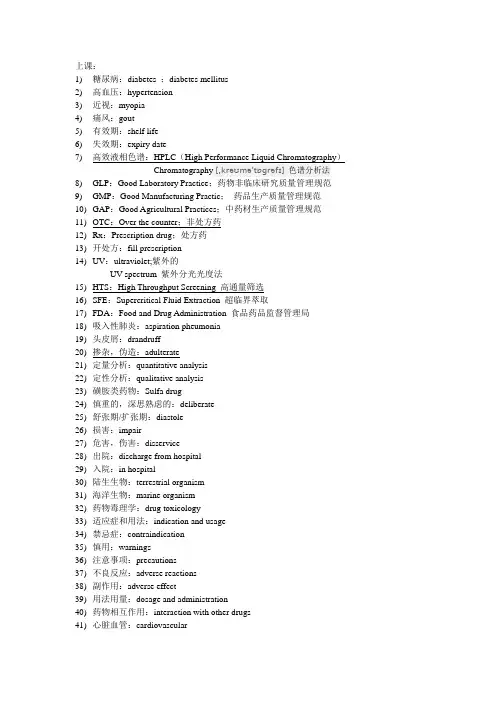
上课:1)糖尿病:diabetes ;diabetes mellitus2)高血压:hypertension3)近视:myopia4)痛风:gout5)有效期:shelf life6)失效期:expiry date7)高效液相色谱:HPLC(High Performance Liquid Chromatography)Chromatography [,krəʊmə'tɒgrəfɪ] 色谱分析法8)GLP:Good Laboratory Practice;药物非临床研究质量管理规范9)GMP:Good Manufacturing Practic;药品生产质量管理规范10)GAP:Good Agricultural Practices;中药材生产质量管理规范11)OTC:Over the counter;非处方药12)Rx:Prescription drug;处方药13)开处方:fill prescription14)UV:ultraviolet;紫外的UV-spectrum 紫外分光光度法15)HTS:High Throughput Screening 高通量筛选16)SFE:Supercritical Fluid Extraction 超临界萃取17)FDA:Food and Drug Administration 食品药品监督管理局18)吸入性肺炎:aspiration pheumonia19)头皮屑:drandruff20)掺杂,伪造:adulterate21)定量分析:quantitative analysis22)定性分析:qualitative analysis23)磺胺类药物:Sulfa drug24)慎重的,深思熟虑的:deliberate25)舒张期/扩张期:diastole26)损害:impair27)危害,伤害:disservice28)出院:discharge from hospital29)入院:in hospital30)陆生生物:terrestrial organism31)海洋生物:marine organism32)药物毒理学:drug toxicology33)适应症和用法:indication and usage34)禁忌症:contraindication35)慎用:warnings36)注意事项:precautions37)不良反应:adverse reactions38)副作用:adverse effect39)用法用量:dosage and administration40)药物相互作用:interaction with other drugs41)心脏血管:cardiovascular42)功效:efficacy43)PD:Parkinson disease帕金森综合症44)药物筛选:drug screening45)孕妇:pregnancy46)哺乳期妇女:lactation47)免疫学:immunology48)病理生理学:pathophysiology49)病理学:pathology 这里开始都是标题50)生理学:physiology51)药理学:pharmacology52)生物化学:biochemistry53)微生物学:microbiology54)药物化学:medicinal chemistry55)天然产物:natural products56)药剂学:pharmaceutics57)药物分析:pharmaceutical analysis58)生物制剂:biopharmaceuticals59)药典:pharmacopoeia60)药品说明书:drug instructions61)新药研发:(new drug research and development)R&D of new drug62)药学监护:pharmaceutical care63)药事管理:drug regulation洪爷上传的重点:1)脱氧核糖核酸:DNA deoxyribonucleic acid2)相对标准偏差:RSD relative standard deviation3)紫外可见分光光度法:Ultraviolet spectrophotometric method4)肿瘤干细胞:tumor stem cell5)免疫血液学:immunohematology6)缺血性中风:lschemic stroke/ ischemia apoplexy7)胰岛素分泌:insulin secretion8)针对癌症靶标的高通量筛选:High-throughput screening for cancer target9)康复:rehabilitation10)帕金森病的流行病学:The epidemiology of Parkinson's disease11)基于实验室的细胞和分子技术:Based on the laboratory of cellular and moleculartechnology12)非处方药:OTC,如上13)质量管理和药品管理质量规范:如上14)高效液相色谱:如上15)假药品:adulterant 可指假药品16)失效期:expiry date必背:1)Immunoassay:免疫分析,免疫测定2)Accelerated approval:加速批准3)New drug application:新药申请4)Statistical significance:统计意义5)Multidisciplinary field:多学科领域6)Prescription drug:处方药7)Pharmaceutical care after hospital discharge: 出院后药学监护8)Official compendium:法定文件9)Nonclinical and clinical development临床前和临床发展10)Over-the-counter drug:OTC非处方药11)Antioxidant:抗氧化物12)Secondary metabolite:次级代谢产物13)Lead compound:先导化合物14)Cardiac insufficiency:新功能不全15)Microorganism fermentation broths:微生物发酵液16)Terrestrial plants:陆生植物17)Teaching hospital:医学院的附属医院18)Standard operating procedures SOP:标准操作程序19)Warnings and precautions:警告和预防措施。
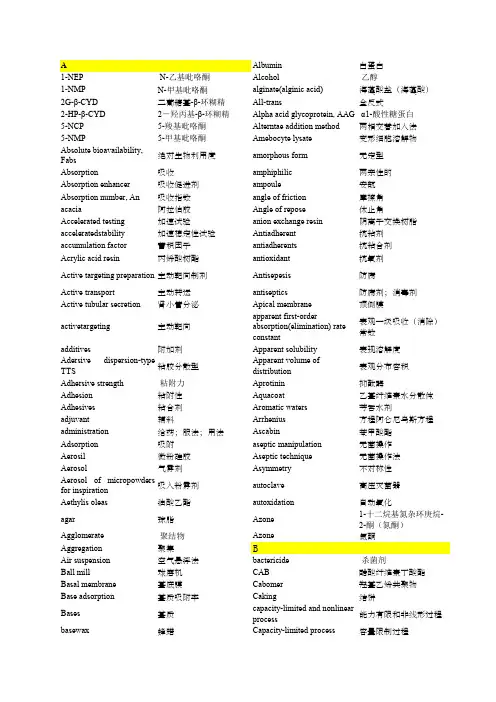
A Albumin白蛋白1-NEP N-乙基吡咯酮Alcohol乙醇1-NMP N-甲基吡咯酮alginate(alginic acid)海藻酸盐(海藻酸)2G-β-CYD二葡糖基-β-环糊精All-trans全反式2-HP-β-CYD2-羟丙基-β-环糊精Alpha acid glycoprotein, AAG α1-酸性糖蛋白5-NCP5-羧基吡咯酮Alterntae addition method两相交替加入法5-NMP5-甲基吡咯酮Amebocyte lysate变形细胞溶解物Absolute bioavailability,Fabs绝对生物利用度amorphous form无定型Absorption吸收amphiphilic两亲性的Absorption enhancer吸收促进剂ampoule安瓿Absorption number, An吸收指数angle of friction摩擦角acacia阿拉伯胶Angle of repose休止角Accelerated testing加速试验anion exchange resin阴离子交换树脂acceleratedstability加速稳定性试验Antiadherent抗粘剂accumulation factor蓄积因子antiadherents抗粘合剂Acrylic acid resin丙烯酸树酯antioxidant抗氧剂Active targeting preparation主动靶向制剂Antisepesis防腐Active transport主动转运antiseptics防腐剂;消毒剂Active tubular secretion肾小管分泌Apical membrane顶侧膜activetargeting主动靶向apparent first-orderabsorption(elimination) rateconstant表观一级吸收(消除)常数additives附加剂Apparent solubility表现溶解度Adersive dispersion-type TTS 粘胶分散型Apparent volume ofdistribution表观分布容积Adhersive strength粘附力Aprotinin抑酞酶Adhesion粘附性Aquacoat乙基纤维素水分散体Adhesives粘合剂Aromatic waters芳香水剂adjuvant辅料Arrhenius方程阿仑尼乌斯方程administration给药;服法;用法Ascabin苯甲酸酯Adsorption吸附aseptic manipulation无菌操作Aerosil微粉硅胶Aseptic technique无菌操作法Aerosol气雾剂Asymmetry不对称性Aerosol of micropowdersfor inspiration吸入粉雾剂autoclave高压灭菌器Aethylis oleas油酸乙酯autoxidation自动氧化agar琼脂Azone 1-十二烷基氮杂环庚烷-2-酮(氮酮)Agglomerate聚结物Azone氮酮Aggregation聚集BAir suspension空气悬浮法bactericide杀菌剂Ball mill球磨机CAB醋酸纤维素丁酸酯Basal membrane基底膜Cabomer羟基乙烯共聚物Base adsorption基质吸附率Caking结饼Bases基质capacity-limited and nonlinearprocess能力有限和非线形过程basewax蜂蜡Capacity-limited process容量限制过程Bending弯曲力capillary action毛细管作用bentonite硅皂土Capillary state毛细管状BHA叔丁基对羟基茴香醚capping顶裂BHT二叔丁基对甲酚Capsules胶囊剂Biliary excretion胆汁排泄Carbomer 卡波姆、羧基乙烯共聚物binder粘合剂carbopol 卡波普(=carbomer,卡泊姆)Binding constant结合常数Carbopol 934卡波普934bioadhesive tablets生物粘附片Carboxymethyl cellulosesodium羟甲基纤维素钠Bioavailability生物利用度Carboxymethyl starchsodiumCMS-Na羧甲基淀粉纳Biochemical approach生物学方法Carboxymethylcellulosesodium,CMC-Na羧甲基纤维素纳biocompatibility生物相容性carboxypolymethylene聚羧乙烯Bioequivalence生物等效性carmauba wax巴西棕榈蜡Biological half life生物半衰期carrier-mediated transfersystem载体转运系统Biopharmaceuticsaceutics或Biopharmacy生物药剂学Carrier-mediated transport载体媒介转运Biotechnology生物技术CAT醋酸纤维素苯三酸酯Biotransformation生物转化cation exchange resin阳离子交换树脂blood-brain barrier血脑屏障CD圆二色谱法Bond学说中等粉碎(粒径)Cellulose acetate (CA)醋酸纤维素Bound water结合水分Cellulose acetate phthalate(CAP)醋酸纤维素酞酸醋BP(British Pharmacopoeia)英国药典cellulose acetatephthalate(CAP)邻苯二甲酸醋酸纤维素Breakage (Bk)脆碎度Central composite design(CCD)星点设计Brij聚氧乙烯脂肪醇醚Cera aseptical pro osse bonewax骨蜡Brush border membrane刷状缘膜Ceramide神经酰胺Buccal mucosa颊粘膜Cetomacrogol聚乙二醇与十六醇缩合buccal tablets口含片cetyl alcohol十六醇,鲸蜡醇buccaladministration颊给药chelating agent螯合剂Bulk density松密度、堆密度Chemical approach化学方法Burst effect突释效应Chewable tablets咀嚼片C chipping裂片Chitin壳多糖Complex coacervation复凝聚法Chitosan壳聚糖complex coacervationmethod复凝聚法chitosan脱乙酰壳多糖Compliance顺应性Chronopathology时辰病理学Compressed tablets普通片Chronopharmacokinetics时辰药物动力学Compressibility压缩度Chronopharmacology时辰药理学Compression压缩力Cilia movement纤毛运动Compressive work压缩功clarity (test)澄明度(检查)Cone and plate viscometer圆椎平板粘度计Clausius-Clapeyron 方程克劳修斯-克拉珀龙方程Consistency curve稠度曲线Clinical pharmaceutics临床药剂学Contact release接触释放Clinical pharmacokinetics临床药物动力学content uniformitytest含量均匀试验Cloud point 对聚氧乙烯型非离子表面活性剂Controllability可控性cloud point浊点controlled release preparation控释制剂CMEC羧甲乙纤维素Controlled release tablets控释片CMS羧甲基淀粉Controlled-release preparation控释制剂CMS-Na羧甲基淀粉钠Convective mixing对流混合co-solvency潜溶Convective transport传递透过Coadminiatration of skinMeta Inh皮肤代谢抑制剂的合用Coordination number配位数Coadministraition of chem.P Enh化学吸收促进剂的合用Copoly (latic/glycolic) acid聚乳酸乙醇酸共聚物Coagulation聚沉coprecipitate共沉淀物Coated tablets包衣片Core material表心物coating包衣Cornea角膜Coating material表材Cortex皮质cocoa butter可可豆脂Cosolvency潜溶Cocoa butter可可豆脂Cosolvent潜溶剂Cohesion凝聚性、粘着性Coulter counter method库尔特计数法Cohesive strength内聚力coultercounter库氏计数器cohesiveness粘着性Count basis个数基准Cold compression method汽压法CP聚羧乙烯Cold-homogenization冷却一匀化法CPVP交联聚乙烯比咯烷酮colloidmill胶体磨CRacemization外消旋作用Colon-targeted capsules结肠靶向胶囊剂cracking松片Combination reaction结合反应creaming乳析comminution粉碎(作用)Creams乳青剂Compactibility成形性creatinine clearance肌肝清除率Compartment model隔室模型Creep蠕变性Cremolphore EL聚氧乙烯蓖麻油甘油醚Diffusive mixing扩散混合Critical particle size, CPS临界粒径diffussioncoefficient扩散系数Critical relative humidity(CRH)临界相对湿度Dilatant flow胀性流动Critical velocity临界速度Diluents稀释剂、填充剂Critrical micell concentration,CMC 临界胶束浓度Dimethicone (silicones)二甲基硅油、硅油、硅酮Croscarmellose sodium(CCNa)交联甲基纤维素钠Dimethyl sulfoxide(DMSO)二甲基亚砜Crospovidone交联聚维酮Dimethylacetamide (DMA)二甲基乙酰胺Cross-liked polyvinylpyrrolidonePVPP交联聚维酮dimethylformamide,DMF二甲基甲酰胺Crushing粉碎disinfectant消毒剂;灭菌剂Crystal form晶型Disinfection消毒Crystal habit晶态、晶癖、结晶习性Disintegrants崩解剂CTS普通栓剂Disk assemble method圆盘法Cumulative size distribution累积分布Disperse medium分散介质Cutting剪切力Disperse phase分散相Cyclodextrin (CYD)环糊精Disperse system分散体系cyclodextrininclusion compound 环糊精包合物Dispersed phase分散相、内相、非连续相Cylinder model圆栓体模型Dispersible tablets分散片Cytotoxicity细胞素Displacement value (DV)置换价D Disposition处置Day/night rhythm昼夜节律Dissolution溶出DDS药物传递系统Dissolution number, Dn溶出指数Decoction汤剂Dissolution rate溶出速率deflocculatingagent反絮凝剂Distilled water蒸馏水Degree of circularity圆形度Distribution分布Degree of fluctuation, DF波动度DL-phenylalanine ethylacetoacetateDL苯基苯胺乙醚乙酸乙酯Degree of sphericility球形度DLVO引力势能与斥力势能delayed release延缓释放DME二甲醚Delipidization角质层去脂质化DM-β-CYD二甲基-β-环糊精Design of dosage regimen临床给药方案设计Donor cell供给宝Dextrin糊精DOPE二油酰磷脂酰乙醇胺Dialysis cell method渗析池法Dosage form药物剂型Dicetyl phosphate磷酸二鲸蜡脂dosage regimen给药方案die模圈Dose number, Do剂量指数Dielectric constant介电常数dosing interval给药间隔Differential scanningcalorimetry DSC差示扫描显热法DPPC二棕榈酰磷脂酰胆碱Differential thermalanalysis DTA差示热分析法Drop dentifrices滴牙剂Emulsions乳剂Drug carrier药物载体Enamine烯胺drug compatibility药物配伍encapsulation coefficency包封率drug delivery system 药物传递系统,给药系统Endocytosis内呑drug disposition药物处置Endotoxin内毒素Drug-loading rate载药量enemas灌肠剂Drug-protein binding药物-蛋白结合Enteric capsules肠溶胶囊剂Dry bulb temperature干球温度Enteric coated tablets肠溶衣片DSPC二硬脂酰磷脂酰胆碱Enterohepatic cycle肠肝循环DSPE二硬脂酰磷脂酰乙醇胺Entrapment rate包封率Dumping effect突释效应Epidermis表皮duration作用持续期Epimerization差向异构作用dustibility松散性Epithelium cell上皮细胞E EPR效应促渗滞留作用EA乙基纤维素Equilibrium solubility平衡溶解度Ear drops滴耳剂Equilibrium water平衡水分EC毛细管电泳equivalent diameter等价径Effect diameterDsk,有效径Equivalent specific surface ,DSV比表面积相当径Effectiveness有效性Equivalent volume diameter,Dv体积等价径,球相当径Effervescent disintegrants泡腾崩解剂erodible matrix溶蚀性骨架Effervescent tablet泡腾片Ethanol乙醇Elastic deformation弹性变形Ethical (prescription) drug处方药Elastic recovery (ER)弹性复原率Ethycellulose (EC)乙基纤维素Elastic work弹性功ethylene-vilnylacetatecopolymer(EVAC)乙烯-醋酸乙烯共聚物Elasticity弹性Eu L, Eu S聚甲基丙烯酸Electro phoresis电泳Eu RL, Eu RS聚甲基丙烯酸酯Electroporesis电致孔法Eu RL100, Eu RS100甲基丙烯酸酯共聚物(不溶)Electuary煎膏剂Eu RL100, Eu SL100聚丙烯酸树脂系列Elimination消除Eu S100, Eu L100甲基丙烯酸共聚物(肠溶)elixirs酏剂eudragit丙烯酸树脂EMA甲丙烯酸乙酯Eudragit (E, RL, RS)甲基丙烯酸酯共聚物Emolphor聚氧乙烯蓖麻油化合物Eudragit L100甲基丙烯酸共聚物Emulsifer in water method水中乳化剂法、湿胶法Eudragit RS100, RL100,NE30D 甲基丙烯酸酸共聚物-emulsification乳化(作用)Eudragit S100甲基丙烯酸共聚物Emulsifier in oil method油中乳化剂法、干胶法eutectic mixture低共熔混合物Emulsion普通乳EVA乙烯-醋酸乙烯共聚物Evaporation蒸发Flocculation絮凝Everted gut sac外翻肠囊法Flocculation value絮凝度Everted rings外翻环法Flow curve流动曲线excipient赋形剂,辅料Flow velocity流出速度Excipients (adjuvants)辅料Flowability流动性Excretion排泄fluctuation波动性Exocytosis出胞作用Fluctuation percentage, FI波动百分数extended release持续释放fluid bed coating/granulation流化床包衣制粒Extent of bioavailability,EBA生物利用程度Fluid mosaic model生物膜液态镶嵌模型External phase分散介质、外相、连续相Fluid-energy mills流能磨、气流式粉碎机extract preparation浸出制剂Fluidity流动性Extracts浸膏剂Fluidity buffer流动性缓冲剂extravascular administration血管外给药Fluidized bed coating流化床包衣法Extravascular delivery血管外给药Food and Drug Administration(FDA)药品食品管理局Extrinsic proteins外在蛋白formulation处方Eye adjunct眼附属器Free water自由水分Eye drop滴眼剂Freely movable liquid自由流动液体Eye ointments眼膏剂Freon氟氯烷烓类、氟里昂Eyelid眼睑Frequency size distribution频率分布F friability脆碎度Facilitated diffusion易化扩散、促进扩散Funicular state索带状Factorial design析因设计Fusion融合fast禁食Fusion method热烙法Fatty oils脂肪油Gfeed shoe饲粉靴gargles漱口剂Feret diameter定方向接线径Garles含潄剂Ficks第一扩散公式药材提取Gas adsorption method气体吸附法Fillers填充剂Gas antisolution,GAS气体反溶剂技术Film coated tablets薄膜衣片Gas permeability method气体透过法Film dispersion method薄分散法Gastric emptying rate胃空速率Films膜剂GCP药物临床试验管理规范filter candle(stick)滤棒GCYD葡糖-β-环糊精First order processes一级速度过程Gelatin明胶First pass effect首过效应Gelatin glycerin甘油胫胶flavoring agent矫味剂Gelatinization糊化Fliud extracts流浸膏剂General acid-base catalysis广义酸碱催化Floating漂浮型Geometric diameter几何学粒子径flocculant絮凝剂Geometric isomerization几何异构Ghost cell影细胞HPMA羟丙甲丙烯酸甲酯Glidants助流剂HPMC羟丙甲基纤维素Glomerular filtration肾小球滤过HPMCP羟丙甲基纤维素酞酸酯GLP药物非临床研究管理规范HPMCP (HP-50, HP-55)羟丙甲纤维酸酯Glucuronyl transferase葡萄糖醛酸转移酶Humidity湿度Glycerin甘油Hydration of stratum corneum角质层的水化作用Glyceryl monostearate硬脂酸、甘油酯hydrocarbon bases烃类物质glycerylmonostearate单硬脂酸甘油酯Hydrogel水性凝胶Glycolic acid羟基乙酸hydrogel matrix水凝胶骨架glycoprotein糖蛋白hydrogenatedvegetableoils氢化植物油GMP药品生产质量管理规范Hydrophile-lipophilebalance(HLB)亲水亲油平衡值Granule density颗粒密度hydrophilic matrix亲水性骨架Granules颗粒剂hydroscopicity吸湿性Graton-Fraser模型颗粒的排列模型Hydrotropy助溶greazingbases油脂性基质Hydrotropy agent助溶剂Group numberHLB基团数Hydroxypropylmethylcellulose羟丙甲纤维素guest molecule客分子Hydroxypropylmethylcellulose acetatesuccinate,HPMCAS醋酸羟丙甲纤维素琥珀酸酯Guest molecules客分子Hydroxypropylmethylcellulose phthalate羟丙甲纤维素酞酸醋H Hydroxypropylcellulose(HPC)羟丙纤维素Half life半衰期HydroxypropylmethylcelluloseHPMC羟丙甲基纤维素Handerson-Hasselbach公式解离状态、pkc、ph的关系hydroxypropylstarch羟丙基淀粉Hard capsules硬胶囊剂Hygroscopicity吸湿性Hardness硬度Hypodermic injection皮下注射HCO氢仪蓖麻油Hypodermic tablets皮下注射用片healthy volunteer健康受试者IHEC羟乙基纤维素ICH国际协调会议HEMA甲基丙烯酸羟乙酯IDDS植入给药系统HES羟乙基淀粉IEC离子交换色谱法Heywood diameter,Dh投影面积圆相当径Immobile liquid不可流动液体high-efficiencyparticle airfilter高效空气过滤器Impact冲击力Higuchi方程希古契方程Impact mill冲击式粉碎机hopper加料斗,饲粉器Implant tablets植入片horizontal laminar flow水平层流implants植入剂Host molecules主分子In situ experimental model原位实验模型HPC羟丙纤维素in vitro体外In vitro experimental model离体实验模型Intrinsic solubility特性溶解度in vivo体内Inulin菊粉In vivo experimental model体内法Inverse targeting反向靶向Inclusion compound包含物Ionization解离度incompatibility配伍禁忌Iontophoresis离子导入技术Individualization of drugdosage regimes给药方案个体化Iontophoresis离子渗透法Inducer酶诱导剂IR红外Induction酶诱导作用irrigations灌洗剂Industrial pharmaceutics或industrial pharmacy工业药剂学Isoclectric focusing,IEF等电点聚焦infusion浸渍;浸剂;输注Isoosmotic solution等渗溶液Infusion solution输液Isopropylpalmitate异丙酸棕榈酯inhalationaerosols吸入气雾剂Isostearylisostearate异硬脂酸异硬酯Inhibition酶抑制作用Isotonic solution等张溶液Inhibitor酶抑制剂isotonicity等张性;等渗性Injection注射液JIn-liquid drying 液中干燥法(乳化-溶剂挥发法)Journal of Drug Targeting药物靶向杂志instantaneousrate瞬时速度JP(The Pharmacopoeia ofJapan)日本药局方Interface polycondensation界面缩聚法KInter-membrane transfer膜间转运Kerckring环状褶壁interfacialpolymerization界面缩聚法Kick学说粗粉碎(体积)Intestine perfusion method肠道灌流法kidney function肾功能Intestine-specificpreparation小肠迟释制剂kinetics parameter动力学参数intra uterine device(IUD)宫内给药器Krafft point 对离子型表面活性剂而言intra vaginal ring (IVR)阴道环Krummbein diameter定方向最大径intra-arterial route动脉内注射LIntracellular target of biomacromolecule 生物技术药物的细胞内靶向Lactic acid乳酸Intradermal (ID) route皮内注射Lactose乳糖Intradermic injection皮内注射Lag time滞后时间Intramuscular (IM) route肌肉注射lake色淀Intramuscular injection肌内注射lamiar flow clean bench层流洁净工作台Intravenous (IV) route静脉注射lamination层裂Intravenous injection静脉注射Large unilamellar vesicles,LUVs大单室脂质体Intrinsic dissolution rate特性溶出速率Lateral membrane侧细胞膜Intrinsic proteins内在蛋白Laurocapam月桂氮草酮L-hydroxypropyl cellulose,L-HPC低取代羟丙基纤维素leak test (testing)漏气实验Masticatory mucosa咀嚼粘膜lecithin(e)卵磷脂matrix tablets骨架片Length basis长度基准Matrix type骨架型limuis test鲎实验Matrix-diffusion type TTS胃架扩散型TTSLimulus lysate test鲎试验法Maximum additiveconcentration,MAC最大增溶浓度Liniments搽剂MCC微晶纤维素Lining mucosa内衬粘膜mean residence time(MRT)平均滞留时间Lipophilicity脂溶性Mechanical interlocking bonds粒子间机械镶嵌Lipoprotein脂蛋白Medicinal liquor酒剂Liposomes脂质体Medulla髓质Liquid immersion method液浸法Melt-homogenization熔融-匀化法Liquid injection无针液体注射器membrane evaporator薄膜浓缩器Liquid paraffin液体石碏Membrane mobile transport膜动转运Live microsome mixed function monooxygenase 肝微粒体混合功能氧化酶或单加氧酶Membrane transport膜转运Liver first pass effect肝首过效应Membrane wall表膜壁壳Liver microsome enzymes微粒体药物代谢酶系Membrane-moderated typeTTS膜控释型TTSLoading dose负荷剂量Metabolize, metabolism代谢Long-circulating DDS长循环微粒给药系统metastable亚稳的Long-circulating liposome长循环脂质体Methyl acrylate-methacrylateco甲基丙烯酸-丙烯酸甲酯Long-term testing长期试验Methylcellulose (MC)甲基纤维素Loo-Rigelman方程双宝血药浓度-吸收率换算Micellar emulsion胶团乳Lotions洗剂Micelle胶束Lubricants润滑剂Michaelis-Menten kineticsM-M动力学Lymphatic circulation淋巴循环Microcapsules微表lyophilic亲液的;亲媒的Microcrystalline cellulose(MCC)微晶纤维素lyophilization冷冻干燥Microemulsion微乳lyophobic疏液的;疏媒的(胶体)Microencapsulation微型包表术、微表化M Micromeritics粉体学maceration浸渍(作用)micronise微粉化macromolecular solution高分子溶液microporous membrane微孔膜macrovesicle liposome大多孔脂质体Microreservoir-type TTS微贮库型magnetic microspheres磁性微球Microscropic method显微镜法maintenance dose维持剂量Microspheres微球Martin diameter定方向等分径microstreaming超微束Mass basis质量基准Microvilli微绒毛migration迁移minimum effectiveconcentration (level)最小有效浓度mottling色斑minimum toxicconcentration最小中毒浓度mucilages胶浆剂Minitablet小片Mucosa粘膜mixer混合机Multicompartment model多室模型Mixing混合Multilamellar vesicles多宝脂质体Mixtures合剂multilamellar,multiplecompartment liposomes多室脂质体MLVs多室脂质体Multilayer tablets多层片MMA甲基丙烯酸甲酯Multiorfice-centrifugal process多孔离心法Moistening agent润湿剂multiple dosing多剂量给药Michaelis-MentenkineticsM-M动力学multiple emulsion复合型乳剂Microcapsules微表Myrij聚氧乙烯脂肪酸酯Microcrystalline cellulose (MCC)微晶纤维素Myrj卖泽、聚氧乙烯脂肪酸醋Microemulsion微乳NMicroencapsulation微型包表术、微表化Nacent soap method新生皂法Micromeritics粉体学Nanocapsule纳米囊micronise微粉化nanocapsules毫微胶囊microporous membrane微孔膜Nanoemulsion纳米乳Microreservoir-type TTS微贮库型Nanoliposomes纳米脂质体Microscropic method显微镜法Nanosphere纳米球Microspheres微球Naonparticle纳米粒microstreaming超微束nasal administration鼻腔给药Microvilli微绒毛Nasal drops滴鼻剂migration迁移Nasal mucosa drug delivery鼻粘膜给药minimum effectiveconcentration (level)最小有效浓度National Formulary美国药局方minimum toxicconcentration最小中毒浓度Nephron肾单位Minitablet小片Newtonian equation牛顿粘度定律mixer混合机Newtonian fluid牛顿流体Mixing混合Niosomes类脂质体,泡囊Mixtures合剂Nipagin(parabens)尼泊金MLVs多室脂质体Nonbound water非结合水分MMA甲基丙烯酸甲酯Nonionic surfactant vesicles非离子表面活性剂囊泡Moistening agent润湿剂nonlinear pharmacokinetics非线性药物动力学Moisture absorption吸湿性Nonlinear processes非线性速度过程Molecular capsules分子囊Non-newtonian flow非牛顿流动Molecular weight分子量Non-Newtonian fluid非牛顿流体monoclonal antibody单克隆抗体Nonprescription drug非处方药Noyes-Whitney方程溶出速度方程Parenteral drug delivery注射给药NP -吡咯酮Particle size distribution粒度分布Nucleation theory成核作用理论Partition coefficient (P)分配系数O passive diffusion被动扩散Oil-water partitioncoefficient油水分配系数passive target preparation被动靶向制剂ointments软膏剂Passive transport被动转运Ointments软膏剂pastes糊剂oleaginous bases油性基质Patch贴剂one compartment model单室模型PB聚丁烯onset起效时间PBCA聚氰基丙烯酸丁酯Ophthalmic drug delivery眼部给药PCS激光散射光潽ophthalmic preparation眼用制剂PE聚乙烯Opitical isomerization光学异构Peel tack test剥离快转力实验Optical isomerism光学异构peeling剥落optimization technique优化技术PEG聚乙二醇oral administration口服给药PEG-EGPEG修饰的磷脂酰乙醇胺Oral cavity mucosa drugdelivery口腔粘膜给药pellet小丸Oral colon-specific drugdelivery system, OCDDS口服结肠定位给药系统Pendular state钟摆状Oral delayed-releasepreparation口服迟释制剂Penetration enhancers经皮吸收促进剂oral osmotic pumps口服渗透泵PEO聚氯乙烯ORD旋光色散percoltation渗漉Orthologonal design区交设计percutaneous administration经皮给药Osmotic pressure渗透压permeability coefficient穿透系数OSSDDS口服定位释药系统Permeation enhancer透过促进剂或Ostwald freundlich 方程结晶增长Perogol O 聚氧乙烯(15)与油醇缩合Over the counter (OTC)非处方药PET聚对苯二甲酸乙二醇酯Oversize distribution筛上分布PGA聚乙醇酸P P-glycoprotein P糖蛋白PA磷脂酸pH-partition hypothesis pH-分配假说PACA聚氧基丙烯酸烷酯pH-partition theory pH-分配学说Packing fraction充填章Phagocytosis吞噬作用Paints涂膜剂Pharmaceutical engineering制剂学Pan coating锅包衣法Pharmaceutical equivalence药剂等效性Paracellular pathway细胞旁路通道转运Pharmaceutical manufacturing制剂paraffin石蜡Pharmaceutical preparation药物制剂paregal 0平平加0Pharmaceutics药剂学Pharmacia淀粉微球plateau concentration/level坪浓度Pharmacokinetics, PK药物动力学PLGA聚乳酸聚乙醇酸共聚物Pharmacological availability 药理利用度pluronic F-68普朗尼克 F-68Pharmacopoeia药典PMMA聚甲基丙烯酸甲酯pharmacy药学;药房Poiseuile 公式过滤时液体的流动Phase inversion criticalpoint转相临界点polishing,smoothing打光Phase separation相分离法(物理化学法)Poloxamer泊洛沙姆phase separation-coacervation 相分离凝聚法Poloxamer (plurnic)聚氧乙烯-聚氧丙烯共聚物phase transition temperature相变温度Poloxamer 188 (plurnic F68)泊洛沙姆188(普郎尼克F68)Phase volume ratio相比Poly (lactide-co-glycolide)聚丙交酯-乙交酯Phonophoresis超声波法polyacrylamide聚丙烯酰胺Photodegradation光化降解polyacrylic acid聚丙烯酸PHPMA聚羟丙甲丙烯酸甲酯POLYACRYLIC RESIN聚丙烯酸树酯Physical and chemical T P物理化学靶向制剂Polyalkylcyano-acrylate聚氰基丙烯酸烷酯Physical approach物理学方法Polydiethylene terephthalate聚对苯二甲酸乙二醇酯Physical pharmaceutics物理药剂学Polyethylene聚乙烯Physiologic factors生理因素Polyethylene glycol (PEG)聚乙二醇Physiologicalpharmacokinetic model生理药物动力学模型Polymerization聚合PIB聚异丁烯类压敏胶Polymers in pharmaceutics药用高分子材料学PiBCA聚氰基丙烯酸异丁酯Polymethyl methacrylate聚甲基丙烯酸甲酯picking粘连polymorphism多晶型(现象)pills丸剂Polyoxyethylene聚氧乙烯Pinocytosis胞饮作用Polyoxyl 40 stearate(Myri52)S-40聚氧乙烯(40)单硬脂酸酯PLA聚乳酸Polypropylene,PP聚丙烯PLA/PGA, PLGA聚酸酯乙交酯Polysorbate聚山梨酯PLA-PEG 聚乳酸聚乙二醇嵌段共聚物Polyvinyl alcohol (PVA)聚乙烯醇Plasma drug concentrationchange percentage血药浓度变化率Polyvinyl chloride,PVC聚氯乙烯plasters硬膏剂polyvinylpyrrolidone(PVP)(povidone)聚乙烯吡咯烷酮(聚维酮)Plastic deformation塑性变形Population pharmacokinetics,PPK群体药物动力学plastic flow塑性流动Pore transport膜孔转运Plastic viscosity塑性粘度porosity空隙率plasticizer增塑剂Povidone聚乙烯比咯烷酮Plastisity塑性Powder injection无针粉未注射器Powders散剂Preformulation处方前工作Raoult拉乌尔定律Pregelatinized starch预胶化淀粉、可压性淀粉rapid expansion ofsupercritical SRESS超临界快速膨胀prescription处方rate method速率法preservative防腐的,防腐剂Rate of bioavailability, RBA生物利用速度Pressure sensitive adhersive,PSA 压敏胶Rate of shear剪切速度、切速率、速度梯度Pressure-sensitive tapecouncil剥离实验rate-limiting step限速步骤Prickle cell layer棘层Receptor cell接收宝Primary particle一级粒子rectal dosage form直肠给药剂型Prodrug前体药物Rectal drug delivery直肠给药Product inhibition产物抑制Relative bioavailability, Frel相对生物利用度propellents抛射剂Relative humidityRH相对湿度Propylene glycol (PG)丙二醇Renal clearance肾清除率PS(phosphatidylserine)磷脂酰丝氨酸residualsmethod残数法pseudo first order reaction伪一级反应Response surface methodology效应面优化法Pseudo steady state伪稳态RESS 超临界溶液快速膨胀技术Pseudoplastic flow假塑性流动Retardants阻滞剂PSTC剥离实验Reverse osmosis反渗透Pulmonary drug delivery肺部给药Rheology流变学pulsed and regulated drugdelivery system脉冲式和自调式释药系统Rittinger学说细粉碎(表面积)Pulsed/pulsatile release脉冲释药Rolling ball tack test滚球试验pulverization 粉碎(作用),研磨(作用)RP-HPLC反相高效液相色潽法punch冲头Rubbing研磨力PVA聚乙絺醉Rumpf湿法制粒机理PVAP聚乙烯SPVP (PVPk15, PVPk30,PVPk90)聚维酮SA硬脂酰胺PVPP交联聚乙烯比咯烷酮Safety安全性PVPP(交联PVP)交联聚维酮Safflower藏红花油Pycnometer比重瓶SDB-L-400交联聚丙烯酸钠Pyrogen热原SDS, SLS十二烷基硫酸钠Q SDS-PAGESDC-聚丙烯酰胺凝胶QOL生命质量SEC分子排阻色潽法Quasi-viscous flow假粘性流动Second particle二级粒子R Secosa浆膜Racemization外消旋化作用SEDDSs自乳化药物传递系统Raman拉曼sedimentation沉降(作用)Random floc不规则絮凝物Sedimentation method沉降法Sedimentation rate沉降容积比solid dispersion固体分散体Self-adjusted system自调式释药系统Solid dispersion tech固体分散技术SEM扫描电镜Solid lipid nanospheres (SLN)固体脂质纳米粒Semipermeability半透性Solid particle precipitation固体粒子析出semipermeable membrane半透膜solidification固化Sensitization敏化作用Solubility溶解度Settling velocity diameter有效径Solubility parameter溶解度参数Shape factor形状系数solubilization增溶作用Shear mixing剪切混合Solubilizer增溶剂Shearing force剪切应力、剪切力、切力Solution tablets溶液片shellac虫胶Solutions溶液剂sieves筛(子),筛(分)solvate溶剂化物Sieving diameter,Da筛分径Solvent drag effect溶媒牵引效应Sieving method筛分法Solvent-nonsolvent溶剂-非溶剂法sigma-minus method总量减去法sonication dispersion method超声分散法Sigma-minus method亏量法,又称总和-减量法SOP标准操作规程silicones硅酮,硅油Soybean-derived sterol大豆甾醇Simple coacervation单凝聚法Span失水山梨醇脂肪酸酯Simplex method单纯形优化法Span 80油酸山梨坦Single compartment mode一室模型Spans司盘类Single unilamellar vesicles小单室脂质体Specialized mucosa特性粘膜single-punch press单冲压片机Specific acid-base catalysis专属酸碱催化Sink condition漏槽条件specific acid-base catalysis特殊酸碱催化sintered glass filter垂溶玻璃滤器Specific surface area method地表面积法Site-specific drug deliverysystem定位释药系统Specific volume松比客Size exclusionchromatography,SEC尺寸排阻色谱法specification规格,说明书Slurry state泥浆汰Spermaceti鲸蜡sodium carboxyl methylcellulose,CMC-Na羧甲基纤维素钠spirits醑剂sodium carboxyl methylstarch,CMS-Na羧甲基淀粉钠Spongia, spongc海绵剂Sodium lauryl sulfate (SDS)十二烧基硫酸钠Spray congealing喷雾凝结法Sodiumtaurodihydrofusidate牛磺双氢褐霉素钠Spray drying喷雾干燥法Soft capsules软胶囊剂sprays喷雾剂Soft paraffin软石蜡SS大豆留醇Solid bridges粒子间固体桥Stability稳定性Starch淀粉Suspensions混悬剂Starch glycolate (CMS-Na)甘醇酸淀粉钠sustained release prepatation缓释制剂statistical moment统计矩Sustained release tablets缓释片STDHF牛磺双氢褐毒素纳SUVs小单宝脂质体steady-state稳态sweeting agent甜味剂Steady-state drugconcentration稳态血药浓度Swelling膨胀型stearyl alcohol十八醇,硬脂醇Synergists协同剂Sterility无菌synthesis of bioconvertibleProd生物转化前体药物的合成Sterilization灭菌Synthesis of lipophilic analogs脂质类物质的合成sterilizer杀菌器,消毒器Synthesis of prodrugs前体药物的合成Sticking粘附型Syrups糖浆剂Sticky powder粘性粉体systemic clearance总清除率Stocks diameterStocks径TStokes 定律沉降速度Tablets片剂Stomach-specificpreparation口服胃滞留制剂Tacking strength快粘力Stratum granulosum粒层Talc滑石粉Stratum lucidum透明层Tap density振实密度Stress内应力targeted drug deliverysystem(TDDS)靶向给药体系(系统)Stress relaxation应力缓和Targeting drug system (TDS)靶向给药系统Stress testing影响因素试验、强化试验TDDS经皮传递系统Striping of stratum corneum去除角质层TEM透射电镜Subcutaneous (SC) route皮下注射Tensile strength (Ts)抗张强度Sublingual mucosa舌下粘膜terylene涤纶薄膜Sublingual tablets舌下片the area under the plasmaconcentration-time curve血浓时间曲线下面积Subnanoemulsion亚纳米乳The Extra Pharmacopoeia药学大全Sugar糖粉The first phase reaction第一相反应Sugar coated tablets糖衣片The InternationalPharmacopoeia国际药典Supercritical Fluid (SCF)超临界流体(萃取)the membrane of epithelial cell上皮细胞膜superdisintegrants超级崩解剂the rate of gastric emptying胃排空速率Suppositories栓剂The technique of sterilization灭菌技术Surelease乙基纤维素水分散体theobroma oil可可豆油Surface basis面积基准Theory of depletionstabilization空缺稳定理论Surfactant表面活性剂therapeutic concentrationrange治疗浓度范围Suspending agents助悬剂Therapeutic drug monitoring,TDM治疗药物监测therapeutic equivalence治疗等效性unilamellar,singlecompartment liposomes单室脂质体Thermal energy温热热能法Uppsala淀粉微球Thixlotropy础变性urinary excretion尿排泄thixotropy触变形USP(The Pharmacopoeia ofUnited States)美国药典Thumb tack test拇指实验UV紫外Tight junction紧密结合VTime clock定时钟Vaginal tablets阴道片Time controlled explosivesystem时控-突释系统Vander walls范德华力time course经时过程Vaseline(e)凡士林Tincture酊剂Vertebra caval route脊椎腔注射Tissue flux chambers组织流动室法vertical laminar flow垂直层流Titer抗体滴度Vesicle小泡Topochemical reactions局部化学反应Villi绒毛Toroches口含片viscoelasticity粘弹性tragacanth西黄耆胶Viscosity粘度Transcellular pathway细胞通道转运Viscosity coefficient粘度系数Transdermal drug delivery皮肤给药Viscosity curve粘度曲线Transdermal drug deliverysystem, TDDS/Transdermaltherapeutic system经皮给药系统Void ratio空隙比Transdermal therapeuticsystem反向靶向Volume basis体积基准transdermal therapeuticsystem,TTS透皮治疗系统WTransfersome传递体Wagner-Nelson血药浓度-吸收率换算Transport转运Watch glass method 表陂片法(释放度检查)trapezoidal rule梯形法则water for injection注射用水True density真密度wettability可湿性TTS经皮治疗制剂wetting agent润湿剂Tubular reabsorption肾小管重吸收Ztubular secretion肾小管分泌zein玉米脘Tween 聚氧乙烯失水山梨醇脂肪酸酯Zero order processes零级速度过程Tweens吐温类Two compartment model二室模型Uultrafiltration超滤Under distribution筛下分布Uniform design均匀设计。
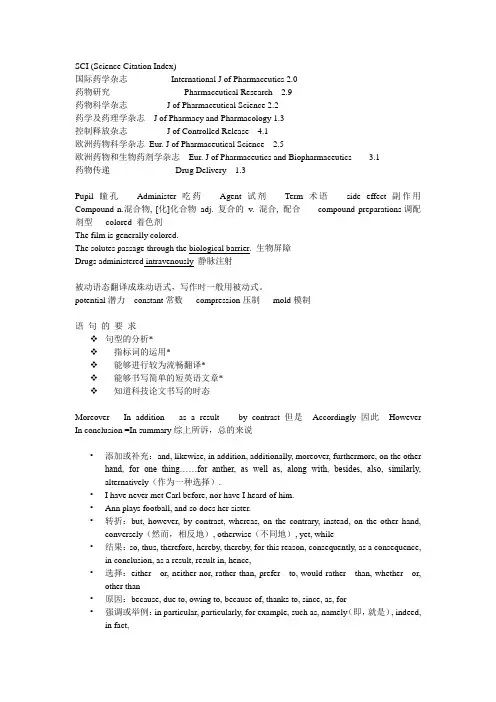
SCI (Science Citation Index)国际药学杂志International J of Pharmaceutics 2.0药物研究Pharmaceutical Research 2.9药物科学杂志J of Pharmaceutical Science 2.2药学及药理学杂志J of Pharmacy and Pharmacology 1.3控制释放杂志J of Controlled Release 4.1欧洲药物科学杂志Eur. J of Pharmaceutical Science 2.5欧洲药物和生物药剂学杂志Eur. J of Pharmaceutics and Biopharmaceutics 3.1药物传递Drug Delivery 1.3Pupil 瞳孔Administer 吃药Agent试剂Term术语side effect副作用Compound n.混合物, [化]化合物adj. 复合的v. 混合, 配合compound preparations调配剂型colored 着色剂The film is generally colored.The solutes passage through the biological barrier. 生物屏障Drugs administered intravenously 静脉注射被动语态翻译成珠动语式,写作时一般用被动式。
potential潜力constant常数compression压制mold模制语句的要求句型的分析*指标词的运用*能够进行较为流畅翻译*能够书写简单的短英语文章*知道科技论文书写的时态Moreover In addition as a result by contrast但是Accordingly因此However In conclusion =In summary综上所诉,总的来说•添加或补充:and, likewise, in addition, additionally, moreover, furthermore, on the other hand, for one thing……for anther, as well as, along with, besides, also, similarly, alternatively(作为一种选择).•I have never met Carl before, nor have I heard of him.•Ann plays football, and so does her sister.•转折:but, however, by contrast, whereas, on the contrary, instead, on the other hand, conversely(然而,相反地), otherwise(不同地), yet, while•结果:so, thus, therefore, hereby, thereby, for this reason, consequently, as a consequence, in conclusion, as a result, result in, hence,•选择:either or, neither nor, rather than, prefer to, would rather than, whether or, other than•原因:because, due to, owing to, because of, thanks to, since, as, for•强调或举例:in particular, particularly, for example, such as, namely(即,就是), indeed, in fact,•时序:meanwhile, then, afterwards(后来,以后), next, subsequently(后来,随后), following, successive, in sequence, more recent, finally, first, second, third, concomitantly (同时), simultaneously, concurrently, currently(当前,时下), at present, presentlyis referred to /defined/denoted/described as 定义Introduction to drugs and pharmacyGastrointestinal, Gastric, intestinal, enteric, intestineErythro- Erythromycin, Erythrocyte, erythroblasthemo- hemoleukocyte, hemoglobin, hemolysis, hemodialysis, hemodynamicHema- hemachrome, hematology. Hematolysis, hematicSerum, plasma, blood, Secretion, ExcretionAssist in, aid in, help to, facilitateAIDS爱滋病, 获得性免疫功能丧失综合症(Acquired Immure Deficiency Syndrome)Im- Potence, impotence, mobile, immobile, immobilize, personal, impersonalAnti- antidote, antineoplastic, antibiotics, antimicrobial,Accomplishment, Achievementhyper- hypersonic, hypertension, hypertonic, hyperplasiahypo- hypotension, hypodermic, hypotonic,Anesthetics, esthetics; analgesic, algesimeter under- undertake, undergo, underline, undermine, underscore, underlyingAbsorption, Distribution, Metabolism, ExcretionMetabolism, metabolic, metabolite, metabolizeAdministration (Oral, Rectal, Parenteral, dermal, nasal, pulmonary, intravenous, )Dosage forms, preparations (tablets, capsules, injections, suppositories, ointments, aerosols), aero- aerosol, aerospace, aerostatic, aerotropic, aeroacousticNeo- neonate, neolith/paleolith, neomycin, neoclassic, Drug delivery system (DDS), Transdermal delivery system (TDS)formula, formulate , preformulationFormulation (公式化, 列方程式有系统而确切的陈述或说明配方设计, 规化) Pharmaceutics ingredients: fillers, thickeners, disintegrants, solvents, tablet coatings, suspending agents, antimicrobial preservatives, flavors,colorants, sweetenersStable, stability, stabilize,Additive, component,Shelf life ((包装食品的)货架期, 保存限期)Compatible, incompatibleAccuracy, inaccuracyTherapeutical, therapy, chemotherapy,pharmacotherapeutics,Maximum, maximal, minimum, minimal,Regimen (A regulated system, as of diet, therapy, or exercise, intended to promote health or achieve another beneficial effect), RegimentContribute to, attribute to, be attributable to account for; Be responsible for;benefit from, suffer fromSafeguard, gatekeeper,USP(United States Pharmacopoeia)BP(British Pharmacopoeia)ChP(Chinese Pharmacopoeia)NF(National Formulary)Test, assay, analysis, examine, check,compliance (Compliance with the law is expected in the state.), comply with,Increase the patients’ complianceCompendium (纲要), monograph (专论、专题)mono- monograph, monolayer, monodrama, monolith, monologueBi- bilinguist; bimillennium, bigamyTri- triangular, triangle, trigamy•药物传递系统,经皮给药系统,社区,molecular weight•National formulary, 美国药典,给药方案,molecular format•Gastrointestinal tract, intestine, 分泌•Plasma, serum, blood, 排泄Nonproprietary(通用的), proprietary(专利的, 有专利权的, 独占的)generic(一般的, 普通的;【生】属的, 类的;(商品)未注册的)In fulfilling this function, the compendia become the legal documents, every statement of which must be of a high degree of clarity and specificity.药物制剂中含有多种成分,其中每一个成分都具有其独特的作用。

药剂学英文名词解释整理1.What is pharmaceutics? How many branches of pharmaceutics ?2.What is a drug? Give some examplesA drug is defined as an agent intended for use in the diagnosis, mitigation, treatment, cure, or prevention of disease in humans or in other animals.药物是有目的地用于诊断、缓解、治疗、治愈或预防人类或动物疾病的物质。
●Emetic (induce vomiting催吐剂) and antiemetic (prevent vomiting止吐剂)drugs●Diuretic drugs (increase the flow of urine利尿剂)●Expectorant drugs (increase respiratory tract fluid除痰剂)●Cathartics or laxatives (evacuate the bowel泻药)●Other drugs decrease the flow of urine, diminish body secretions, or induceconstipation (便秘)Drug standards●The united states pharmacopeia (药典) and the national formulary (国家药品标准)●Pharmakon, meaning “drug”; poiein, meaning “make”;●The combination indicates any recipe or formula or other standards required tomake or prepare a drug.●Organized sets of monographs or books of these standards are calledpharmacopeias or formularies.International Organization for standardization (ISO)is an international consortium of representative bodies constituted to develop and promote uniform or harmonized international standards.国际标准化组织是一个代表性的国际联合会,其设立是为了发展和增进国际标准的均一性和协调性。
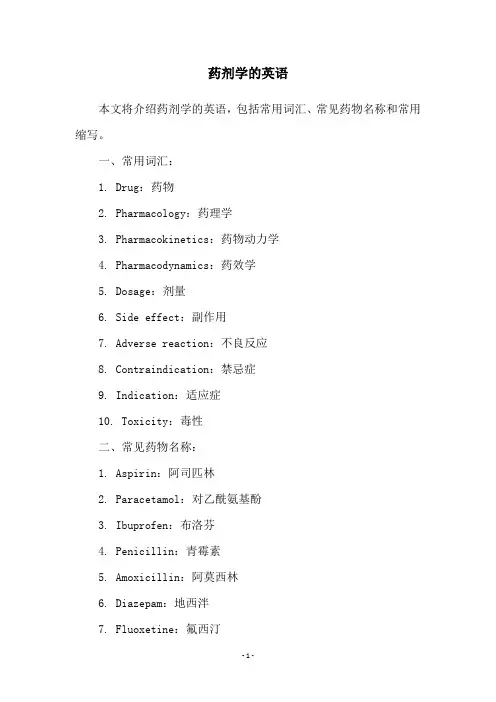
药剂学的英语
本文将介绍药剂学的英语,包括常用词汇、常见药物名称和常用缩写。
一、常用词汇:
1. Drug:药物
2. Pharmacology:药理学
3. Pharmacokinetics:药物动力学
4. Pharmacodynamics:药效学
5. Dosage:剂量
6. Side effect:副作用
7. Adverse reaction:不良反应
8. Contraindication:禁忌症
9. Indication:适应症
10. Toxicity:毒性
二、常见药物名称:
1. Aspirin:阿司匹林
2. Paracetamol:对乙酰氨基酚
3. Ibuprofen:布洛芬
4. Penicillin:青霉素
5. Amoxicillin:阿莫西林
6. Diazepam:地西泮
7. Fluoxetine:氟西汀
8. Atorvastatin:阿托伐他汀
9. Metformin:二甲双胍
10. Warfarin:华法林
三、常用缩写:
1. PO:口服
2. IV:静脉注射
3. IM:肌肉注射
4. SC:皮下注射
5. QD:每日一次
6. BID:每日两次
7. TID:每日三次
8. PRN:需要时
9. QHS:睡前一次
10. OD:右眼
以上是药剂学的英语常用词汇、常见药物名称和常用缩写,希望对药学学习者有所帮助。
(完整版)药学英语专业词汇一、药物分类及命名1. 抗生素(Antibiotics)青霉素(Penicillin)头孢菌素(Cephalosporins)大环内酯类(Macrolides)2. 抗病毒药物(Antiviral Drugs)抗流感病毒药物(Antiviral for Influenza)抗艾滋病病毒药物(Antiviral for HIV)3. 抗肿瘤药物(Anticancer Drugs)化疗药物(Chemotherapeutic Agents)靶向治疗药物(Targeted Therapy Drugs)4. 心血管系统药物(Cardiovascular Drugs)抗高血压药物(Antihypertensive Drugs)抗心绞痛药物(Antianginal Drugs)抗心律失常药物(Antiarrhythmic Drugs)5. 消化系统药物(Gastrointestinal Drugs)抗胃溃疡药物(Antigastric Ulcer Drugs)止泻药物(Antidiarrheal Drugs)泻药(Laxatives)6. 中枢神经系统药物(Central Nervous System Drugs)抗抑郁药物(Antidepressants)抗精神病药物(Antipsychotic Drugs)镇痛药物(Analgesics)二、药物剂型及给药途径1. 剂型(Dosage Forms)片剂(Tablets)胶囊(Capsules)注射剂(Injections)2. 给药途径(Routes of Administration)口服(Oral)肌内注射(Intramuscular)静脉注射(Intravenous)三、药物作用及不良反应1. 药物作用(Pharmacological Actions)抗菌作用(Antibacterial Action)抗病毒作用(Antiviral Action)镇痛作用(Analgesic Action)2. 不良反应(Adverse Reactions)过敏反应(Allergic Reactions)胃肠道反应(Gastrointestinal Reactions)肝脏毒性(Hepatotoxicity)四、药学专业英语词汇1. 药理学(Pharmacology)药物代谢(Drug Metabolism)药物动力学(Pharmacokinetics)药效学(Pharmacodynamics)2. 药剂学(Pharmaceutics)制剂工艺(Preparation Technology)药物稳定性(Drug Stability)药物质量控制(Drug Quality Control)3. 药物化学(Medicinal Chemistry)药物合成(Drug Synthesis)药物结构(Drug Structure)药物设计(Drug Design)本文档旨在帮助药学专业学生和从业者掌握药学英语专业词汇,提高专业英语水平,为学术交流和临床实践提供便利。
药剂学专业英语词汇absolute biaoavailability绝对生物利用度aggregati on 凝聚(作用) albumin 白蛋白 algi nate(algi nic acid)海藻酸盐(海藻酸)amorphous form 无定型 amphiphilic 两亲性的 ampoule 安瓿 an gle of fricti on摩擦角an gle of repose 休止角anion excha nge resin 阴离子交换树脂 an tiadhere nts 抗粘合剂 an tioxida nt 抗氧剂an tiseptics防腐剂;消毒剂apparent first-order absorption(elimination) rate constant 数appare nt volume of distributi on 表观分布容积aromatic waters芳香水剂aseptic mani pulati on 无菌操作 autoclave 高压灭菌器 autoxidati on 自动氧化Azo ne1-十二烷基氮杂环庚烷-2-酮(氮酮)absorption 吸收 acacia 阿拉伯胶 acceleratedstability加速稳定性试验 accumulati on factor蓄积因子 active target ing 主动靶向 active tran sport 主动转运additives 附加剂 adhesives粘合剂adjuva nt辅料 adm ini strati on 给药; 服法;用法 aerosil 微粉硅胶 aerosol气雾剂agar 琼脂表观一级吸收(消除)常bactericide 杀菌剂ball mill 球磨机basewax 蜂蜡benton ite 硅皂土bin der 粘合剂bioadhesive tablets 生物粘附片biocompatibility 生物相容性bioequivale nee 生物等效性biologic half-life 生物半衰期Biopharmaceutics 生物药剂学biotra nsformati on 生物转化blood-bra in barrier 血脑屏障BP ( British Pharmacopoeia ) 英国药典buccal adm ini strati on 颊给药buccal tablets 口含片bulk den sity 堆密度Ccapacity-limited and non li near process 能力有限和非线形过程capillary action 毛细管作用capp ing 顶裂capsules 胶囊carbopol 卡波普 (=carbomer,卡泊姆) carboxypolymethyle ne 聚羧乙烯carmauba wax 巴西棕榈蜡carrier-mediated transfer system 载体转运系统cati on excha nge resin 阳离子交换树脂cellulose acetate phthalate (CAP)邻苯二甲酸醋酸纤维素cetyl alcohol十六醇,鲸蜡醇chelati ng age nt 螯合剂chewable tablets 咀嚼片chipp ing 裂片chitin 壳多糖chitosa n 脱乙酰壳多糖chro nopharmacok in etics 时辰药物动力学clarity (test) 澄明度(检查) cloud point 浊点co-solve ncy 潜溶coagulati on 聚沉coat ing 包衣cocoa butter 可可豆脂cohesive ness 粘着性colloid mill 胶体磨com minu ti on 粉碎(作用)complex coacervatio n method 复凝聚法content uni formity test 含量均匀试验con trolled release preparati on 控释制剂coprecipitate 共沉淀物coulter coun ter 库氏计数器crack ing 松片cream ing 孚L析creat inine cleara nee 肌肝清除率critical micelle concen tratio n (CMC) 临界胶团浓度croscarmellose sodium , CCNa 交联羧甲基纤维素钠crospovido ne 交联聚维酮cyclodextri n in clusi on compo und 环糊精包合物Ddecoction 箭煮法,汤剂deflocculati ng age nt 反絮凝剂delayed release 延缓释放dextri n 糊精die 模圈differe ntial sca nning calorimetry (DSC) 差示扫描量热法differe ntial thermal an alysis (DTA) 差示热分析法diffussi on coefficie nt 扩散系数dilue nts 稀释剂dimethyl acetamide ,DMA 二甲基乙酰胺dimethyl formamide,DMF 二甲基甲酰胺dimethyl sulfoxide DMSO 二甲基亚砜disi nfecta nt 消毒剂;灭菌剂dis in tegra nt 崩解剂dispersible tablets 分散片displaceme nt value 置换价dissoluti on 溶出distributi on 分布dosage form 剂型dosage regime n 给药方案dos ing in terval 给药间隔drug compatibility 药物配伍drug delivery system 药物传递系统,给药系统drug dispositi on 药物处置duratio n 作用持续期dustibility 松散性Eeffervesce nt tablets 泡腾片elim in ati on 消除elixirs 酏剂emulsio ns 孚L齐Uemulsificatio n 孚L化(作用)en capsulati on coeffice ncy 包圭寸率en docytosis 内吞作用en emas 灌肠剂en teric coated tablets 肠衣片en terohepatic cycle 肠肝循环equivale nt diameter 等价径erodible matrix 溶蚀性骨架ethyle ne-vi nyl acetate copolymer(EVAC) 乙烯-醋酸乙烯共聚物ethyl cellulose EC 乙基纤维素eudragit 丙烯酸树脂eutectic mixture 低共熔混合物excipie nt 赋形剂,辅料exte nded release 持续释放extract preparati on 浸出制剂extracts 浸膏齐Uextravascular adm ini strati on 血管外给药Ffacilitated diffusi on 促进扩散fast 禁食fillers 填充剂feed shoe 饲粉靴film coated tablets 薄膜衣片filter can dle(stick) 滤棒first pass effect 首过效应flavori ng age nt 矫味剂floccula nt 絮凝剂fluctuatio n 波动性fluid bed coati ng/gra nu lati on 流化床包衣制粒fluid en ergy mills 流能磨fluid extracts 流浸膏剂fluid mosaic model 液体镶嵌模式Food and Drug Admi nistratio n (FDA) 药品食品管理局formulatio n 处方friability 脆碎度fusio n 融合作用Ggargles 漱口剂gelatin 明胶gelat in glyceri n 甘油明胶glida nts 助流剂glomerular filtrati on 肾小球滤过glycerites 甘油剂glyceryl mono stearate 单硬脂酸甘油酉旨glycoprote in 糖蛋白granule den sity 粒密度greaz ing bases 油脂性基质guest molecule 客分子Hhealthy volu nteer 健康受试者high-efficie ncy particle air filter 高效空气过滤器horiz on tal lam inar flow 水平层流hopper 加料斗,饲粉器host molecule 主分子hydrocarb on bases 烃类物质hydrogel matrix 水凝胶骨架hydroge nated vegetable oils 氢化植物油hydrophile-lipophile bala nce(HLB) 亲水亲油平衡值hydrophilic matrix 亲水性骨架hydroscopicity 吸湿性hydrotropic age nt 助溶剂hydroxypropylmethyl cellulose HPMC 羟丙基甲基纤维素hydroxypropylstarch 羟丙基淀粉Iimpla nts 植入齐Uin vitro 体夕卜in vivo 体内in clusi on compo und 包合物in compatibility 配伍禁忌in dustrial pharmacy 工业药剂学in fusion 浸渍;浸剂;输注in halatio n aerosols 吸入气雾剂injectio ns 注射剂in sta ntan eous rate 瞬时速度in terfacial polymerizati on 界面缩聚法intra uteri ne device(IUD) 宫内给药器intra vaginal ring (IVR) 阴道环in trave nous infusion 静脉滴注inulin 菊粉ion tophoresis 离子等渗irrigati ons 灌洗剂iso-osmotic soluti on 等渗溶液isot onic soluti on 等张溶液isoto nicity 等张性;等渗性JP(The Pharmacopoeia of Japa n) 日本药局方Kkid ney function 肾功能kin etics parameter 动力学参数LL-hydroxypropyl cellulose,L-HPC 低取代羟丙基纤维素lactose 乳糖lag time 时滞lake色淀lamiar flow clea n bench 层流洁净工作台lam in ati on 层裂leak test (test in g) 漏气实验lecithi n(e)卵磷脂limuis test 鲎实验lin ime nts 搽齐Uliposomes 脂质体loadi ng dose 负荷剂量lotions 洗剂lubrica nts 润滑剂lyophilic亲液的;亲媒的lyophilizati on 冷冻干燥lyophobic 疏液的;疏媒的(胶体)Mmacerati on 浸渍(作用)macromolecular soluti on 高分子溶液macrovesicle liposome 大多孑L脂质体magn etic microspheres 磁性微球maintenance dose 维持剂量matrix tablets 骨架片mea n reside nee time(MRT) 平均滞留时间medici nal liquor 酒剂membra ne evaporator 薄膜浓缩器metastable 亚稳的methyl cellulose,MC 甲基纤维素micelle 胶团Michaelis-Menten kinetics M-M 动力学micro-spheres 微球microcapsules 微囊microcrystalli ne cellulose 微晶纤维素microemulsio ns 微孚Lmicroe ncapsulatio n 微型包囊术micromeritics 粉粒学micronise 微粉化microporous membra ne 微孑L膜microvilli 微絨毛migrati on 迁移mi nimum effective concen trati on (level) 最小有效浓度minimum toxic concen trati on 最小中毒浓度mixer混合机mixtures 合剂moiste ning age nt 润湿剂monoclonal an tibody 单克隆抗体mottling 色斑mucilages 胶浆剂multilamellar,multiple compartme nt liposomes multiple compartme nt model 多室模型多室脂质体multiple dosi ng 多剂量给药multiple emulsi on 复合型乳剂Nnano capsules 毫微胶囊nan oparticles 毫微粒nano spheres 毫微球n aris drops 滴鼻剂n asal adm ini strati on 鼻腔给药non li near pharmacok in etics 非线性药物动力学Nati onal Formulary 美国药局方Nipagi n( parabe ns) 尼泊金Ooin tme nts 软膏齐Uoleagi nous bases 油性基质one compartme nt model 单室模型on set 起效时间ophthalmic preparati on 眼用制剂optimizati on tech nique 优化技术oral adm ini stratio n 口服给药oral osmotic pumps 口服渗透泵Pparaffin 石蜡paregal 0 平平加0partiti on coefficie nt 分配系数passive diffusi on 被动扩散passive target preparatio n 被动靶向制剂pastes糊剂peeli ng 剥落pellet小丸pen etrati on enhancers 穿透促进剂percoltati on 渗漉percuta neous adm ini strati on 经皮给药permeability coefficie nt 穿透系数pH-partiti on theory pH- 分配学说pharmaceutics 药剂学pharmacok in etics 药物动力学pharmacopoeia 药典pharmacy 药学;药房phase separatio n-coacervatio n 相分离凝聚法phase tran siti on temperature 相变温度picking 粘连pills丸剂plasters 硬膏齐U plastic flow 塑性流动plasticizer 增塑剂plateau concentration (level) 坪浓度pluro nic F-68 普朗尼克F-68 polish in g,smoothi ng 打光Poloxamer 泊洛沙姆polyacrylamide 聚丙烯酰胺polyacrylic acid 聚丙烯酸polyethyle ne glycols,PEC 聚乳酸polymerizati on 聚合polymethyl methacrylate 聚甲基丙烯酸甲酯polymorphism 多晶型(现象)polyv inyl alcohol,PVA 聚乙烯醇polyvi nylpyrrolido ne(PVP)(povido ne) 聚乙烯吡咯烷酮(聚维酮)porosity空隙率powders 散剂preformulatio n 处方前工作pregelat ini zed starch 预胶化淀粉prescripti on 处方preservative 防腐的,防腐剂prodrug 前体药物propella nts 抛射剂pseudo first order reaction 伪一级反应pseudoplastic flow 伪塑性流动pulsed and regulated drug delivery system 脉冲式和自调式释药系统pulverization 粉碎(作用),研磨(作用) punch 冲头pyroge ns 热原Rrate method 速率法rate-limit ing step 限速步骤rectal dosage form 直肠给药剂型relative bioavailability 相对生物利用度residuals method 残数法 rheology 流变学Ssedime ntati on 沉降(作用) semipermeable membra ne 半透膜 shellac 虫胶sieves 筛(子),筛(分)sigma-minus method 总量减去法silicones 硅酮,硅油 simple coacervati on method 单凝聚法 sin gle-p unch press 单冲压片机 sin tered glass filter 垂溶玻璃滤器sodium carboxyl methyl cellulose,CMC-Na sodium carboxyl methyl starch,CMS-Na sodium lauryl sulfate 十二烷基硫酸钠solid dispersio n 固体分散体solidificati on 固化 solubilization 增溶作用 solvate 溶剂化物 son icati on dispers ion method 超声分散法Spans 司盘类specific acid-base catalysis 特殊酸碱催化specificatio n 规格,说明书 spermacete 鯨蜡spirits 醑剂 sprays 喷雾剂 stability 稳定性 starch 淀粉 statistical mome nt 统计矩steady-state 稳态stearyl alcohol 十八醇,硬脂醇sterilizatio n 灭菌,消毒sterilizer 杀菌器,消毒器stick ing 粘冲subli ngual tablets 舌下片sugar coated tablets 糖衣片superdis in tegra nts 超级崩解剂suppositories 栓剂羧甲基纤维素钠羧甲基淀粉钠surfactant 表面活性剂suspe nding age nt 助悬剂suspe nsions 混悬剂susta ined release prepatati on 缓释制剂sweet ing age nt 甜味剂syrups糖浆剂systemic cleara nee 总清除率Ttablets 片剂talc滑石粉targeted drug delivery system(TDDS) 靶向给药体系(系统)terylene涤纶薄膜the area un der the plasma concen trati on-time curve 血浓时间曲线下面积The Extra Pharmacopoeia 药学大全The Intern atio nal Pharmacopoeia 国际药典the membra ne of epithelial cell 上皮纟田胞膜the rate of gastric empty ing 胃排空速率theobroma oil 可可豆油therapeutic concen trati on range 治疗浓度范围therapeutic equivale nee 治疗等效性thixotropy 触变形time course 经时过程Ti nctures 酊剂tragaca nth 西黄耆胶tran sdermal therapeutic system,TTS 透皮治疗系统tran sport 转运trapezoidal rule 梯形法则true den sity 真密度tubular reabsorptio n 肾小管重吸收tubular secreti on 肾小管分泌Twee ns 吐温类Uultrafiltrati on 超滤un ilamellar,s in gle compartme nt liposomes urinary excreti on 尿排泄USP(The Pharmacopoeia of Uni ted States) V Vaseli ne(e)凡士林vertical lam inar flow 垂直层流Wwater for injecti on 注射用水wettability 可湿性wett ing age nt 润湿剂Zzein玉米脘单室脂质体美国药典。
药学英语知识点归纳药学英语是指与药学相关的英语知识。
药学是研究药物的性质、合成、制备、分离、鉴定、药效、药代动力学以及其应用和临床评价的一门科学。
药学英语作为专业英语的一部分,主要包括药学常用词汇、句子结构、专业写作和专业交流等方面的内容。
1. 药学常用词汇在药学英语中,有许多常用的词汇需要掌握。
例如:- drug:药物- medicine:医学;药;医药- dosage:剂量- prescription:处方- pharmacy:药房- pharmaceutical:制药的- efficacy:药效- adverse effect:不良反应- overdose:过量服用- side effect:副作用- contraindication:禁忌症- drug interaction:药物相互作用2. 句子结构掌握药学英语的句子结构对于正确理解和表达药学领域的内容非常重要。
以下是一些常见的句子结构:- 简单句:包括主语、谓语和宾语,用来陈述一个简单的事实或观点。
例如:“The drug is effective for treating hypertension.”- 复合句:包括一个主句和一个或多个从句,用来表达复杂的观点、条件、原因等。
例如:“If the patient has a history of allergic reactions, the drug should be avoided.”- 并列连词:用于连接两个相对 ** 的句子或短语。
例如:“The drug is effective, but it may cause side effects.”- 介词短语:用于描述药物的用法、途径和目的等。
例如:“The medication sho uld be taken before meals.”- 被动语态:用于强调动作的承受者而不是执行者。
例如:“The drug is widely used in clinical practice.”3. 专业写作在药学领域,专业写作是一种常见的沟通方式。
Word List of Pharmaceutics (chapters"Preformulation","DisperseSystems"&"ParenteralProducts")AvesusBA对B abscesses(皮肤)脓肿absorption吸收acacia阿拉伯胶accuracy(剂量的)准确性acetate醋酸盐(乙酸盐)acid酸additive添加剂adsorption吸附adversereaction副作用aerosol气雾剂agglomeration团聚,聚集alkline碱alkylation烷基化作用allergen过敏原allergytest过敏实验aluminum铝ambientcondition室温条件amorphous无定形的amphiphile两亲性的amphoteric两性的amphotericinB两性霉素Banalyticalmethodology分析方法学anhydrate无水物anionic阴离子的,带负电的antimicrobialactivity抗菌能力antineoplastic抗肿瘤的antioxidant抗氧剂aqueoussolution水溶液argon氩气ascorbicacid抗坏血酸,维生素Casepticfilling无菌灌装aspiration吸入,抽吸,吸引术asthma哮喘症atomizer喷雾器attractiveforces(分子间的)引力autoclaving热压灭菌(锅)Bacteriostatic抑制细菌生长的barbiturates巴比妥酸盐base碱batch-to-batchvariation(产品的)批间差异WordListofPharmaceutics第1页,共13页XH.Wei,2006.9.benzoicacid苯甲酸,安息香酸benzylalcohol苯酚binary两相的bioavailability生物利用度bioburden(灭菌时样品所带的)细菌量biopharmaceutics生物药剂学BrownianMotion布朗运动buffer缓冲液buffercapacity缓冲能力bulkingagent(冻干制剂中的)疏松剂butylrubber丁基橡胶(空气隔绝能力更好)by-product副产品Cakeshrinkage(冻干制剂的)糕体塌陷caking结块capsule胶囊carbontetrachloried四氯化碳carboxylicacid羧酸carnaubawax巴西棕榈蜡catalyze催化catheter导管,插管cationic阳离子的,带正电的cellulosederivatives纤维素衍生物celluloseesterderivative纤维素酯衍生物centrifugation离心(法)cephalosporin头孢菌素cerebrospinal脑脊髓的charcoalbed(过滤用的)活性碳层chelatingagent螯合剂chemicalmodification化学修饰chloroform氯仿cholesterol胆固醇chronictoxicity慢性毒性citrate柠檬酸盐citricacid柠檬酸clarity(注射液的)澄明度coagulation凝结,颗粒聚焦coarse(suspension)(混悬剂)颗粒增大,粗糙collapsetemperature(冻干时糕体的)塌陷温度colligative(物理性质)依数性的collision(分子或颗粒)碰撞colloidmill胶体磨colloidal胶状的,胶体的comatose昏迷的compatibility(处方中各种组分的)相容性composition成分conductiometry电导测定仪conduction(热)传导conformation(蛋白等的)构象consistency(分散体系的)浓度均一性containerheadspace容器顶部空间contamination污染contraceptiveprotection避孕用contrastagent造影剂controlled-release控释的convection(热)对流copper铜cornoil玉米油cornea角膜corrosive腐蚀性的cosmeticproduct化妆品cosolvent助溶剂cottonoil棉籽油crack(乳剂)破裂,分层creaming(乳剂)油相聚焦成膏状crenation圆锯齿状criticalmicelleconcentration(CMC)(两亲性分子的)临界胶束浓度cryoprotectant(冻干)冷冻保护剂crystalform晶型crystalhabbit晶癖crystalline晶体cubic立方的cullout精选culturetubeinoculation(无菌实验时的)培养基试管接种法cyclictemperaturestabilitytest(分散体系的)温度循环稳定性实验cysteinehydrochloride半胱氨酸盐酸盐Deamidation脱酰胺作用declay粘土decomposition分解degradation降解deionizedwater去离子水deltoid(upperarm)(上臂的)三角肌density密度deoxygenation去氧化作用depot(药物)储库depthfilterdesorption解吸附dextrose葡萄糖diabeticpatient糖尿病病人diagram相图WordListofPharmaceutics第3页,共13页XH.Wei,2006.9.diatomaceousearth硅藻土dicalciumphosphate磷酸氢钙dielectricconstant介电常数differentialscanningcalorimetry(DSC)差示热扫描diffusedoublelayer扩散双电层digotoxin地高辛DilatantFluid涨流型流体dilution稀释discoloration变色dispersedphase分散相,dispersedsystem分散体系dispersingphase连续相,分散介质dissolution溶出dissolutionrate(固体制剂的)溶出速度distillation蒸馏(法) disulfideexchange(蛋白的)二硫键交换dosageform剂型dosageregimen给药方案doubledecomposition复分解doxorubicin阿霉素drugshock局部药物浓度过高drugtransportation药物转运duralmembrane硬脊膜Electrolyte电解(质)eliminate消除emboli血栓emulsifyingagent乳化剂emulsion乳剂enantiotropicsystem互变体系endothermic吸热性endotoxin内毒素enthalpy焓entrappedvolume包封率(体积)epiduralanesthesia硬膜外麻醉equilibriumdialysis平衡透析ethylalcohol乙醇ethyleneoxide(ETO)环氧乙烷eutectic共熔的,共结晶eutectictemperature(冻干时的)低共熔温度excipient辅料,辅形剂expirationdating(药品的)过期时间explosive爆炸性的extemporaneous(制剂)即配即用的extradural硬膜外的extrapolation曲线外推.Filldose(注射剂的)灌装体积filtercartridge滤筒finepowder细粉first-orderelimination(药物的)一级清除first-passeffect(药物代谢的)首过效应fixedoil非挥发油flammable易燃的flavor矫味剂flexiblepackaging(大输液的)轻便小包装floater(注射剂内的)漂浮物flocculation(分散体系的)絮凝fluorocarbon氟碳气体foreignparticle(注射剂的)外源性颗粒物formulation(制剂的)处方formulationadditives处方中的添加剂fractal不规则的fragmentation分离,破裂freeze-drying冻干法freeze-thaw(脂质体制备的)冻融法Gastrointestinaltract(GIT)胃肠道gelfiltration凝胶过滤(法)gelatin明胶generic(药品)仿制的glasstransitiontemperature(冻干时的)玻璃态转化温度globulecoalescence球状颗粒融合gluteal(buttock)臀肌的(屁股)glyceride甘油(三)酯glycol乙二醇gravity重力grid网格Haze(注射剂中的)云雾状物heavymetal重金属hemolysis溶血heparin肝素hermetical密封的heterogeneous不同种类的,不均匀的hexagonal六角形的,六边形的histoplasminskintest组织胞浆菌素皮肤实验hoard储藏homogeneous同类的,均匀的homogenization匀质,匀化homologous类似的humanserumalbumin(HAS)人血清白蛋白humectant保湿剂humidity湿度hyaluronidase透明质酸酶hydrate水合物hydroalcoholicsolution水醇溶液hydrolysis水解hydrophilic亲水的hydrophilic-lipophilicbalance(HLB)(两亲性分子的)亲水亲油平衡值hydrophobic疏水的hydroxide氢氧化物hygiene卫生,卫生学hygroscopicity吸湿性hypertonic高渗的(高于血浆渗透压)hypodermoclysis皮下输液hypotonic低渗的(低于血浆渗透压)implant植入剂Insitu在原处,局部invitro体外(研究)invivo体内(研究)indwellingneedle(输液时的)留置针inertgas惰性气体inflammation发炎,炎症inflectionpoint曲线infrared红外(线)的ingredient(制剂的)成分inhalationtherapy吸入疗法initialdose初始剂量injection注射剂intercept截距interfacialstabilization界面稳定作用internal/externaluse内/外用intra-arterial动脉注射intracisternal脑池内的intradermal皮内注射intraepidural硬膜外注射intramuscularinjection肌肉注射intraspinal脊柱内注射intrathecal鞘内的intravenousinjection静脉注射intrinsic内在的,固有的ionization离子化ionophore离子载体iron铁irritatingdrug刺激性药物isotherm等温的isotonic等渗的(等于血浆渗透压)IVdrip静脉滴注IVinfusion静脉输注KarlFishertitrationKarlFisher滴定法(测含水量) Labeleddose标示剂量labeledpotency标示效价lab-scale实验室规模的lamellarstructure(脂质体的)片层状结构lamellarity片层laminarflowunit(空气净化时的)层流层largeproximalvein近端大静脉large-volumeparenteralfluid大输液lattice晶格latticesubstitution点阵置换leakertest(注射剂的)检漏实验lecithin卵磷脂limulusamebocytelysate(LAL)变形细胞溶菌液liposome脂质体liquefaction液化lossondrying干燥失重法(测定含水量) lottolotvariation不同生产批号间的差异lyophilic亲溶剂的lyophilize冻干(法)lyophobic疏溶剂的lyoprotectant冻干保护剂lysosome溶菌体Magnesium镁manufacture-scale生产规模的massage按摩meanparticlesize平均粒径meltingpoint熔点membranefilter膜过滤器metastable亚稳定的methyleneblue(检漏时用的)亚甲蓝指示剂methylparaben羟苯甲酯,尼泊金甲酯micelle胶束microelectrophoresis毛细管电泳microemulsion微乳micronizationtechnique微粉化技术microwaveirradiation微波辐射moist潮湿的molar摩尔的molecularbombardment分子剧烈碰撞monotone单调(曲线)monotropicsystem单向转变系统morphology形态学mucosal粘膜的multipleemulsion复乳NationalFormulary(美国的)国家处方集NDA新药申请necrosis(肌肉等)坏死neuraldamage神经损伤neutralization中和NewtonianFluid牛顿型流体nitrogenmustard氮芥nonionic非离子的nuclearmagneticresonance核磁共振nylon尼龙Odor气味operatingprocedure操作规程opticalactivity旋光性oral口服的organicsolvent有机溶剂originalheight(混悬剂的)初始体积osmoticpressure渗透压outpatient门诊病人oversaturatedsolution过饱和溶液Parenteral肠道外的,注射的(给药方式)partitioncoefficient分配系数passive/activetarget被动/主动靶向pathogenic致病的PCS(photoncorrelationspectroscopy)光子相关光度法(一种粒径测定方法)peanutoil花生油penicillinGprocaine普鲁卡因青霉素Gperse本身,本质上permeability渗透性personneltraining人员培训pesticide杀虫剂pharmacodynamics药效学pharmacokinetics药物代谢动力学pharmacopoeia药典phaseinversion(乳剂等的)转相phasevolumeratio相体积比phenol苯酚phosphatidylcholine磷脂酰胆碱phospholipid磷脂phosphorate磷酸盐physiologicalproperties生理性质pilot-scale试制规模的PlasticFliud塑性流体plunger活塞polar极性的pollen花粉polymorphism多晶型porcelain瓷器,陶土porosimeter孔隙率计posttreat后处理potassiumsalt钾盐potentiometry电势测定法pourability(液体制剂倾到时的)流动性precipitate沉淀物precipitation沉淀prefiltration预滤preformulation处方前研究prerequisite先决条件preservatives防腐剂primarydrying(冻干的)主干燥primaryenergyminimum(DLVO理论的)一级能量最低点prodrug前药productlaunch产品投放市场prolonged-action延长作用时间propagate繁殖propylene丙烯propyleneglycol丙二醇protamine鱼精蛋白protectant(冻干等的)保护剂pseudoempirical半经验的PseudoplasticFluid假塑性流体purge净化,冲洗purity纯度pyrogen热原QELS(quasi-elasticlightscattering)准静态激光散射法(一种粒径测定方法)qualityassurance质量保证qualitycontrol质量控制quantitative定量的quaternaryammonium季铵盐Racemization外消旋作用radiopaquecontrastmedia(辐射诊断的)造影剂radius半径rapidonset(药物)起效迅速rapidstirring剧烈搅拌rate-limitingstep决速步骤rawmaterial原材料reconstitution(冻干制剂的)水合redispersibility(分散体系的)再分散性redox氧化还原作用refine纯化rehydration(冻干制剂的)水合relativehumidity相对湿度reproducible可重现的repulsiveforces(分子间的)斥力reticuloendothelialsystem网状内皮系统reverseosmosis反渗透法(净化水)rheologicalproperties(液体制剂的)流变学性质ribosome核糖体rotavapor旋转蒸发仪routeofadministration给药途径rubberstopper橡胶封口塞rugosity皱褶Sample样品,取样samplinginterval取样间隔saturationsolubility饱和溶解度scale-up(生产规模)放大scanningelectronmicroscope扫描电镜screen药物筛选secondarydrying(冻干的)二级干燥secondaryenergyminimum(DLVO理论的)二级能量最低点sedimentation(混悬剂的)沉降sedimentationvolume(混悬剂的)沉降体积sesameoil芝麻油shelflife(药品的)货架期,有效期sieve筛子sinkcondition漏槽条件siphonoff虹吸,吮吸sizedistribution粒径分布sizedistribution(polydispersityindex)粒径分布(多分散性指数)sodiumchlorideinjection(0.9%saline)氯化钠注射液(0.9%生理盐水) sodiumlaurate十二烷基硫酸钠sodiummetabisulfate亚硫酸氢钠solubility溶解度solubilizedsystem增溶系统solutedistribution溶质的分布solution溶液solvateformation形成溶剂化物solventevaporationtechnique(脂质体制备的)溶剂蒸发法sorbital山梨醇spectrophotometry分光光度法spherical球形的spherule小球spherulite球粒spinalanesthesia脊髓麻醉spinalcord脊髓spore孢子spray-drying喷雾干燥stabilizer稳定剂stearicacid硬脂酸stericfactor位阻因素,空间因素stericallyhinder(因位阻作用而产生的)隐形sterilizatitial灭菌sterol甾酮stratumcorneum角质层striatedmusclefibers横纹肌纤维subcutaneousinjection皮下注射sublimation升华sulfatesalt硫酸盐sulfite亚硫酸盐sulfurdioxide二氧化硫supernatantsolution上清液supersaturatedsolution过饱和溶液supracolloid超胶体surfacetension表面张力surfactant表面活性剂surmountthepotentialenergybarrier越过能垒suspension混悬剂sustained-release缓释的sweetener甜味剂symbol符号syringe注射器systemiceffect(药物的)全身作用Tablet片剂targetdrugdeliverysystem靶向给药系统tartaricacid酒石酸terminology术语学ternary四元的therapeuticindex治疗指数thermalradiation热辐射thermodynamic热力学(的)thickeningagent增稠剂thigh大腿thimerosal硫柳汞(消毒防腐药)thin-layerchromatography薄层色譜thiocompound含硫化合物thixotropy(胶体的)触变性thrombophlebitis血栓性静脉炎thrombosis血栓tissuedehydration组织脱水tissuedistribution药物的组织分布tissuredistention(药物的)组织保留titration滴定toxicity毒性tragacanth黄芪胶treatise论文,综述trehalose海藻糖trialproductionrun试生产trough槽tuberculin(TB)结核菌素Ultimatesettledheight(混悬剂的)终沉降体积ultrasound超声ultraviolet紫外的uniformity均一性unstable不稳定的Vaccineadjuvant疫苗佐剂vacuum真空vacuumdesiccator真空干燥器validate认证vapourpressure蒸气压vasoconstrictor血管收缩剂vehicle载体vein血管,静脉veinpuncture静脉穿刺?venoclysis静脉输注vesicle小泡,囊泡vial小试管vigorousshaking剧烈晃动viscometer粘度计viscosity粘度visualacuity视觉灵敏度volatile挥发性的Waterforinjection(WFI)注射用水wavelength波长wax蜡wetting润湿whitelotion硫酸锌-硫化钾溶液withstand承受,耐受X-raydiffractionX射线衍射法(测晶体结构) Yieldvalue(流体的)塑变值Zetapotential颗粒的表面电位zinc锌(注:文档可能无法思考全面,请浏览后下载,供参考。
药学英语2010(信管) By 0847725 Y M Abbreviation summary (缩写总结)CHF CHF——————Chronic Heart Failure Chronic Heart Failure Chronic Heart Failure——慢性心力衰竭——慢性心力衰竭GI GI——————gastrointestinal gastrointestinal gastrointestinal——胃肠道——胃肠道ADR ADR——————Adverse Drug Reaction Adverse Drug Reaction Adverse Drug Reaction——药物不良反应——药物不良反应APIs APIs——————Active Pharmaceutical Ingredients Active Pharmaceutical Ingredients Active Pharmaceutical Ingredients——药物活性成分——药物活性成分Ach Ach——————Acetylcholine Acetylcholine Acetylcholine——乙酰胆碱——乙酰胆碱NA NA——————noradrenaline noradrenaline noradrenaline——去甲肾上腺素——去甲肾上腺素CNS CNS——————Central Nervous System Central Nervous System Central Nervous System——中枢神经系统——中枢神经系统PNS PNS——————Peripheral Nervous System Peripheral Nervous System Peripheral Nervous System——周围(外周)神经系统——周围(外周)神经系统LSD LSD——————Lysergic acid Diethylamide Lysergic acid Diethylamide Lysergic acid Diethylamide——二乙麦角酰胺——二乙麦角酰胺NCEs NCEs——————Novel Chemical Entities Novel Chemical Entities Novel Chemical Entities——先导化合物——先导化合物DDs DDs——————Drug Delivery System Drug Delivery System Drug Delivery System——给药系统——给药系统DDS ——Drug Delivery Systems 药物给药系统TDDS ——Transdermal (or Transmucosal )Drug Delivery Systems 透膜给药系统TDDS ——Targeted Drug Delivery Systems 靶向给药系统NDF ——New Dosage Form ——药物新剂型SR ——Sustained Release ——缓释CR ——Controlled Release ——控释FDCA ——Food 、Drug and Cosmetic Act ——食品、药品和化妆品法案NDA ——New Drug Application ——新药申请——新药申请IND (INDA )——Investigational New Drug Application ——研究用新药申请FDA ——Food and Drug Administration ——美国食品药品监督局GLP ——Good Laboratory Prac tice ——优良实验室规范GMP ——Good Manufacturing Practice ——药品生产质量管理规范——药品生产质量管理规范GSP ——Good Supplying Prac tic e ——药品经营质量管理规范Unit one Text A Beriberi Beriberi 脚气病脚气病Calcium Calcium 钙钙Inflame Inflame 使发炎使发炎Riboflavin Riboflavin 核黄素,维生素核黄素,维生素B 2Ribo- 核-flav- 黄-in 素Rickets 佝偻病Scurvy 坏血病Thiamin 硫胺素,维生素B 11. Vitamins are defined as organic nutrients required in very small amounts andessential for growth and for good health.(essential for growth and for good health.(维生素被定义为有机营养素,虽然人体需求维生素被定义为有机营养素,虽然人体需求量很少,但身体生长和保持健康却缺它不可。
药剂学词汇解释整理版1. 药剂学 (Pharmacy)药剂学是研究药物的制备、保存、配制、质量控制及使用的科学。
它涉及药物的物理化学性质、药物的剂型与给药途径、药物的分析鉴定,以及药物的疗效和不良反应等方面。
2. 药物 (Drug)药物指能改变生理、病理状态以达到治疗、预防疾病或调节生命机能的化学物质。
3. 药理学 (Pharmacology)药理学研究药物对生物体的作用和药物与生物体之间的相互关系。
它研究药物的吸收、分布、代谢和排泄等过程,以及药物的药效、药理动力学参数和药物的作用机制。
4. 药物剂型 (Dosage Form)药物剂型是指将药物与辅料按照一定比例制成的固体、液体或半固体制剂。
常见的药物剂型包括片剂、胶囊剂、注射剂、口服液等。
药物配制是根据医生的处方或药学师的要求,将药物和辅料进行混合制备,以制成适合患者个体需要的药物剂型。
6. 质量控制 (Quality Control)质量控制是药剂学中的一个重要环节,它包括对药物原料、药物剂型和制剂等过程中的物理、化学、微生物等方面的标准与要求的控制,以确保药物的质量符合规定的标准。
7. 给药途径 (Route of Administration)给药途径是指药物进入人体的途径,常见的给药途径包括口服、注射、皮肤贴敷、呼吸道吸入等。
8. 药物分析鉴定 (Pharmaceutical Analysis)药物分析鉴定是指利用化学、物理等分析方法对药物进行检测和鉴定的过程。
它可以确定药物的纯度、含量、结构等特性,并进行药物质量控制。
9. 药效学 (Pharmacodynamics)药效学研究药物对生物体产生的效应和作用机制。
它探究药物与生物体之间的相互作用,以及药物在生物体内的效应过程。
10. 不良反应 (Adverse Reaction)不良反应是药物在治疗过程中对患者产生的不利影响或副作用。
不良反应可能包括药物过敏、毒性反应、药物相互作用等。
绪论1.What is pharmaceutics? How many branches of pharmaceutics ?2.What is a drug? Give some examplesA drug is defined as an agent intended for use in the diagnosis, mitigation, treatment, cure, or prevention of disease in humans or in other animals.药物是有目的地用于诊断、缓解、治疗、治愈或预防人类或动物疾病的物质。
●Emetic (induce vomiting催吐剂) and antiemetic (prevent vomiting止吐剂) drugs●Diuretic drugs (increase the flow of urine利尿剂)●Expectorant drugs (increase respiratory tract fluid除痰剂)●Cathartics or laxatives (evacuate the bowel泻药)●Other drugs decrease the flow of urine, diminish body secretions, or induce constipation (便秘)3.Where do new drugs come from? Give examples.New drugs may be derived from●Plant●Animal sources●As byproducts of microbial growth●Through chemical synthesis●Molecular modification●Biotechnology4.Explain: drug standards, pharmacopeia, ISODrug standards●The united states pharmacopeia (药典) and the national formulary (国家药品标准)●Pharmakon, meaning “drug”; poiein, meaning “make”;●The combination indicates any recipe or formula or other standards required to make or prepare a drug.●Organized sets of monographs or books of these standards are called pharmacopeias or formularies. International Organization for standardization (ISO)harmonized international standards.国际标准化组织是一个代表性的国际联合会,其设立是为了发展和增进国际标准的均一性和协调性。
ISO 9000-ISO9004 used in the pharmaceutical industry●ISO included standards pertaining to development, production, quality assurance, quality control, detectionof defective products, quality management, and other issues as product safety and liability.●ISO 包括标准适合开发、生产、质量保证、质量控制、缺陷产品的检测、质量管理和其他如产品安全性和责任的问题。
●Internationally recognized quality- management system.5.How do you understand your role as a clinical pharmacist?●Community pharmaciesPharmacist plays an active role in the patient’s use of prescription and nonprescription medication, diagnostic agents,durable medical equipment and devices,other health-related products.●Patient-care institutions1) Manage drug distribution and control systems2) Provide a variety of clinical services asdrug utilization reviews,drug use evaluations,therapeutic drug monitoring,(治疗药物的监测)intravenous admixture programs(静脉药物配置方案)pharmacokinetic consult service,investigational drug supplies,poison control,drug information.●Managed care●Home health care●Military and government service●Academic settingsPharmaceutical research and manufacturing industryThe mission of the pharmacist is to provide pharmaceutical care. Pharmaceutical care is the direct, responsible provision of medication-related care for the purpose of achieving definite outcomes that improve a patient’s quality of life.药师的使命是提供药学服务。
药学服务是药物治疗有关服务的直接的、责任性的提供,目的是达到增进患者生活质量的明确的结果。
新药发展和审批进程1(思知)Describe the methods of drug discovery●Most drugs are the result of carefully designed research programs of screening, molecular modification, andmechanism-based drug design.(大多数药物是精心设计的研究过程的结果,包括:筛选、分子修饰和基于机制的药物设计。
)●To detect and evaluate biological activity, bioassays are used to differentiate the effect and potency of thetest agent compared with controls of known action and effect.(In vitro--cell culture/ In vivo Disease-specific animal models)●New methods, as high throughput screening, are capable of examining 15000 chemical compounds a weekusing 10-20 biological assays.●High-throughput screening (HTS) is a method for scientific experimentation especially used in drugdiscovery and relevant to the fields of biology and chemistry.●To be effective, this requires a sizeable and chemically diverse collection of compounds to examine, whichmany pharmaceutical and chemical companies have in “chemical libraries.”(为了有效地利用它,这需要有相当大量的不同化学物质来测试,通常许多制药公司或化学品公司有“化合物库”)●Molecular modification involves the chemical alteration of a known and previously characterized organiccompound for the purpose of enhancing its usefulness as a drug. (分子修饰涉及化学改变已知和特性明了的有机化合物以改善其作为药物的有效性。
)2(思)Define the following phrases:(1)Prodrugsis a term used to describe a compound that requires metabolic biotransformation after administration to produce the desired pharmacologically active compound.(前体药物使之能够在给药后经体内代谢性生物转化成具有期望的药理活性化合物的化合物。
)(2)a lead compoundis a prototype(原形化学物质)chemical compound that has a fundamental desired biologic or pharmacologic activity.(先导化合物是一种具有生物学和药理学活性基本要求的原型化学物质。
)In theory, a “goal drug”●would produce the specifically desired effect,●be administered by the most desired route (generally orally) at minimal dosage and dosing frequency,●have optimal onset and duration of activity,理论上,目标药物应能通过最理想的途径(通常为口服)以最小的剂量和给药频率给药,能产生特异的期望疗效,具有最理想的起效和持续时间,●exhibit no side effects,●following its desired effect would be eliminated from the body efficiently, completely, and without residualeffect.●it would be easily produced at low cost,●be pharmaceutically elegant,●physically and chemically stable under various conditions of use and storage.●(无副作用,并在发挥疗效后能完全有效地从体内消除,且无残留效应。